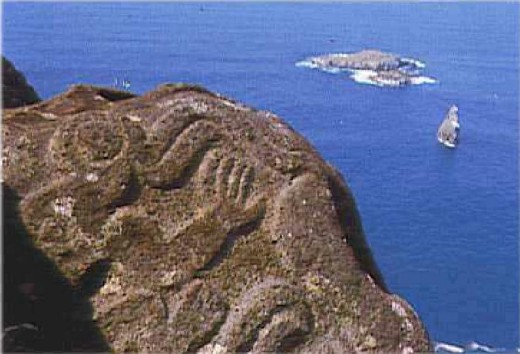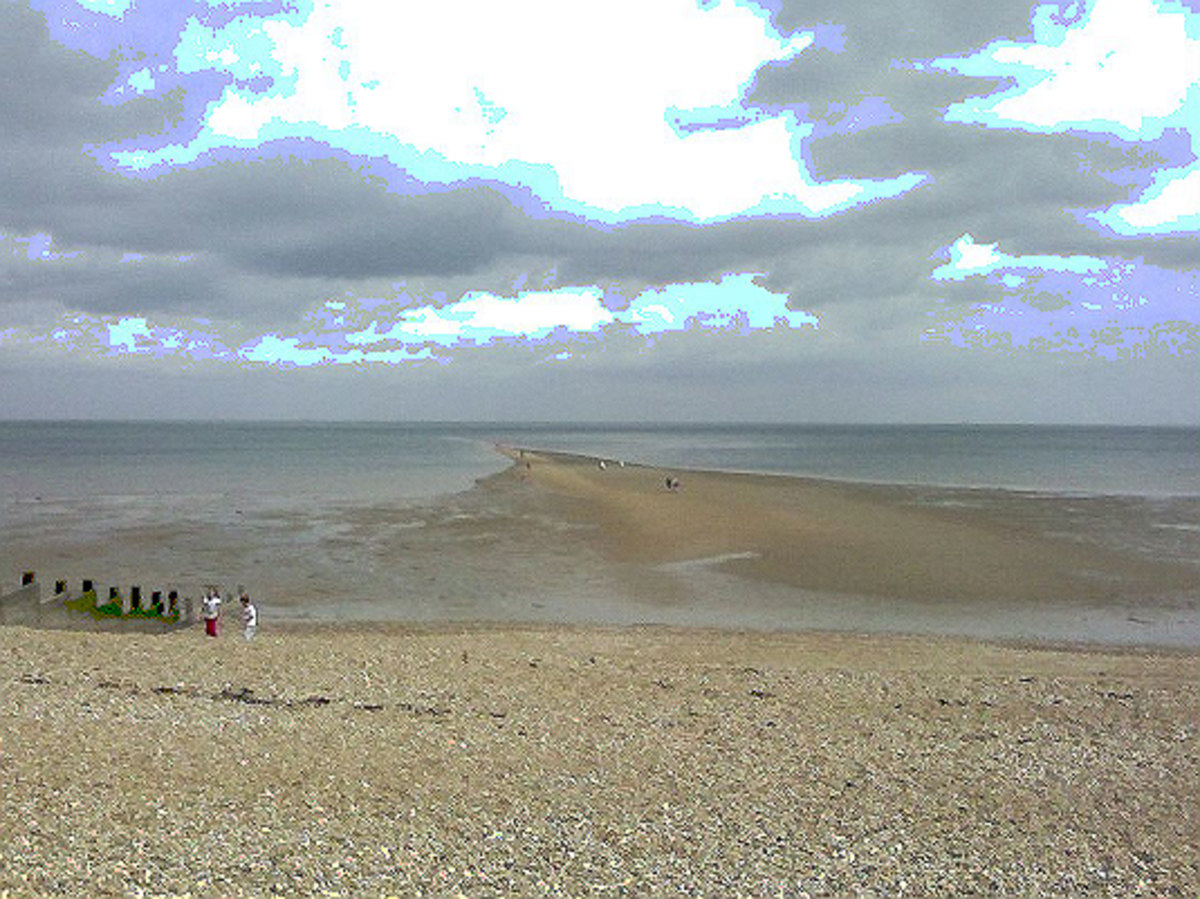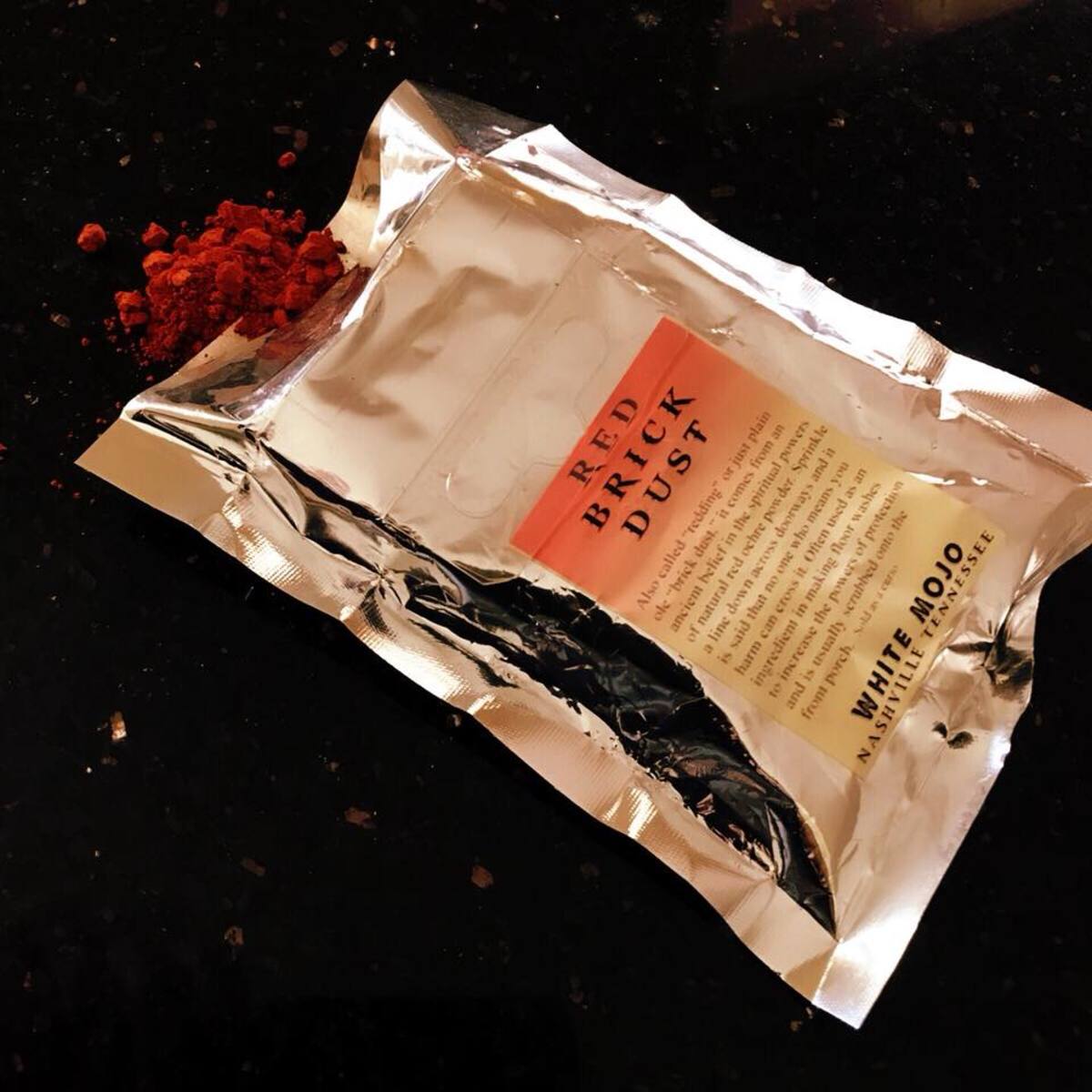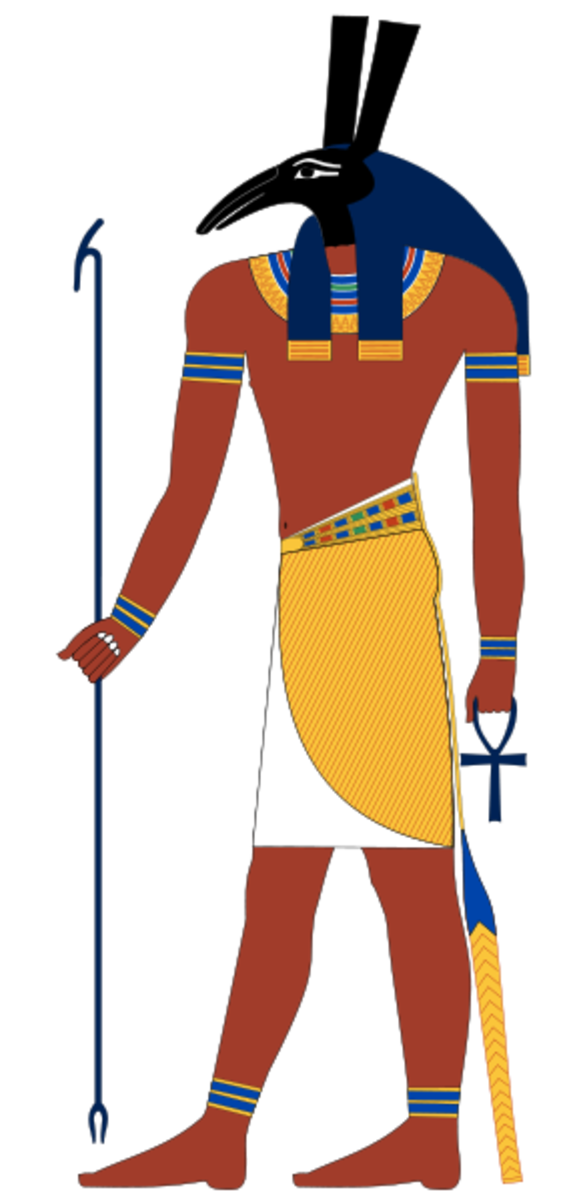The Landscape Zodiac of Britain part 10 Taurus - Mayday
When I started writing this series of articles about the astrology of the landscape and the peoples on-it, I thought it'd be achievable that I could keep them in-synch with the seasons and the signs - you-know - I'd publish the Aries article on the 1st degree of Aries, the Taurus piece on the first day of Taurus etc etc. I managed it up-until the Aries article which turned-out to be a lot longer and more time-consuming than I'd imagined. So that's why this Taurus article is behind-time - today the Sun entered Gemini and I'm only just starting this - I'm a month behind and so is this article.
Alignments from Hinge to Sunrise
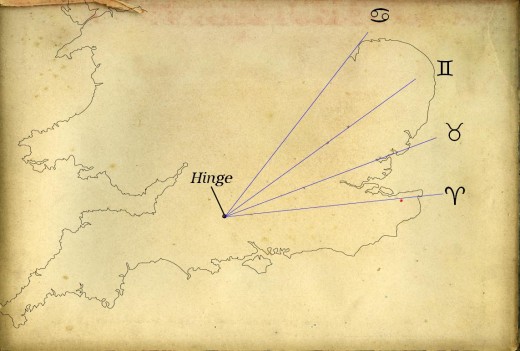
I thought we'd start with the alignments from The Hinge, as usual, and then go-on to look at the global implications of this thing. I have to say that writing this stuff has given me an entirely different perception of astrology and what the different zodiac signs mean - as well as how they got these attributes in the first-place. So, for example, when I think of, say, Aquarius and its influence I now think of what I discovered when I drew the Aquarius alignments on the globe and discovered that Greece, the Pyramids and Saudi Arabia were within the Aquarius sector. It's given me an insight I could never have achieved in a million-years of deep-thought on astrological mythology and philosophy, nor if I'd read every astrological text-book on the subject. All I'm saying is that this down-to-earth approach helps (me) to make sense of the seemingly crazy world on which we co-exist, and my hope is that my efforts might be of some use to you, my reader.
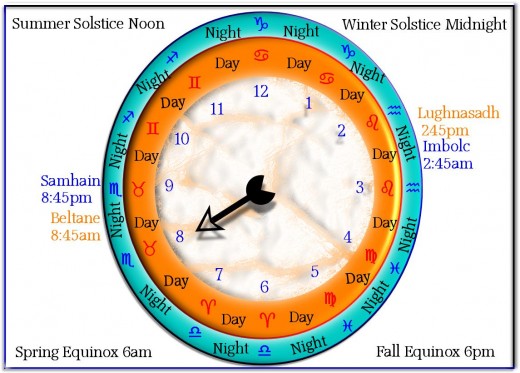
Taurus Atributes
Element Fixed Earth
Desire/Aspiration
Ruling planets Venus and the Moon
Totem animal Bull
Orientation North East
Body Throat, Thyroid (the voice)
Time 8 - 10am
Seasonal rituals Beltane, May-day
Second house Wealth
Metals Gold, Copper, Brass
Tarot Arcana 2 and 5, the High Priestess and the Heirophant
Beltane
Whilst the Sun is transiting through the sign of the Bull, it passes through a cross-quarter point - I've marked it on the ritual-wheel - it's now six-weeks since the Sun emerged from the Underworld at Ostara/Easter/Equinox - and six-weeks is 40 days (+2).
40, you'll recall, is a number that's all to-do with gestation and birth - or a test and trial followed by victorious resolution (all being well of course). In Biblical terms 40 is also used as a code-word for hard-test and trial. In the Great Flood of Noah's day it rained for 40 days and nights; and Jesus was tested in the desert for 40 days and nights. In human terms a babe is in the womb for 40 weeks - a test and trial for both the mother and the child, followed by a victorious resolution - the emergence into the light of day.
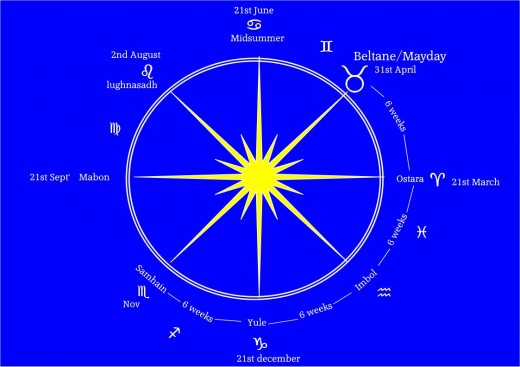
the Apis Bull
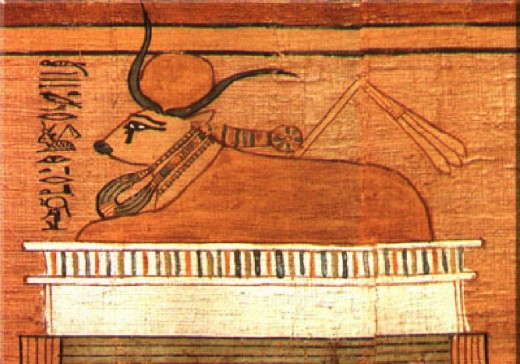
the sin of the calf
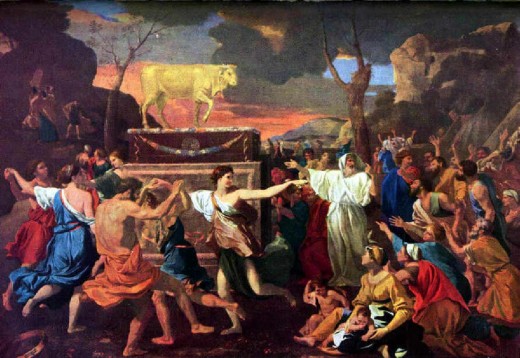
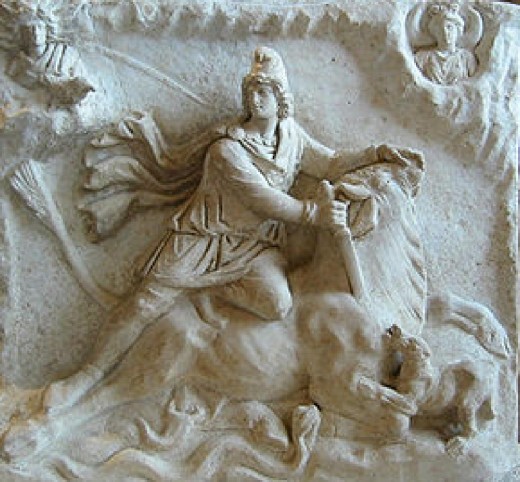
The cow and bull have been venerated since the dawn of time.....
The ancient Egyptians worshipped the Apis Bull - Herodotus wrote: the Apis Bull, is the calf of a cow which is never able after to have another. The Egyptians believe that a flash of lightning strikes the cow from heaven, and thus causes her to conceive the Apis. It has distinctive marks. It is black, with a white diamond on its forehead, the image of an eagle on its back, two white hairs on its tail and a scarab-beetle mark under its tongue.
The Apis bulls were considered to be the earthly incarnation of a god - but unlike other animals who could only intercede with deities on behalf of humans, the Apis Bull was believed to be the god himself living amongst humans. The Bulls were chosen for their special markings and were treated as gods on earth - when they died they were mourned, mummified and buried with the same majesty and ceremony as at the death of a pharaoh.
At the time of the Exodus - when Moses left the Israelites and ascended Mount Sinai to receive the ten tenets from Yahweh, the Israelites made a golden-calf, copying their former-masters, the Egyptians, and worshipped it. This upset Moses quite a lot and he made them destroy it. The Hebrews called this incident the Sin of the Calf.
Bull worship was wide-spread in ancient times - even here in Britain - the Druids would sacrifice two white Bulls before collecting mistletoe, for example. Because the Romans brought their Mediterranean version with them, when they came to Britain on their Roman Holiday, the better-known of these Bull veneration 'cults,' was called Mithraism. In our own, native version, the central figure was known as Ogma, the origin of the name of the runic script, Ogham.
Their version of Bull worship, Mithraism, was the first universal religion of the ancient world, pre-dating Christianity by thousands of years. The rituals of Mithraism are so similar to Christianity that many believe that the Christians borrowed most of their symbols and rituals from it. And there’s plenty of evidence lurking around to fuel those suspicions - for instance, in the Bible no mention of the actual birth date of Jesus is, or was ever recorded - whilst in Mithraism 25th December, the winter solstice on the Julian calendar, was absolutely essential to the meaning of the story. Which is that Mithras, the Sun-God, was born of an immaculate Virgin but instead of a stable it was a cave - and three shepherds came visiting and brought gifts for the messiah.
At the rituals the congregation would be baptised, eat a piece of bread with a cross baked onto it, and drink red wine that was symbolic of blood. Mithraist’s called themselves “brother” and were led by a priest called “father.” The symbols of the father were a staff, a hooked sword, a ring and hat.....nah....it doesn’t sound like Christianity to me - more-like a trick pulled by the Devil, to try and mock Jesus!!
That’s what the Christian Fathers said when they discovered the cult.
The trouble was, you see, that instead of nailing the Sun-God to a post like good Romans, this bugger Mithras gets into a chariot pulled by a magic horse (of course) and rides off into the sky, escaping the nails. Drat, I hate it when that happens. The Christians put a stop to it soon enough though - pagan devilry. They got the 5th century Emperor Diocletian to outlaw the religion, and then they smashed up nearly all of the temples.
The classic depiction of the Mithraic mythos shows Mithras and a Bull. Mithras has his foot on the Bull's back, one hand holding its head, with the other stabbing the Bull in the neck where blood gushes out. Around him there is a dog, a raven, a scorpion, a snake, a lion, a cup and an ear of wheat is growing from the tip of the bulls tail.
He wears the sky for his cloak with the stars, the signs of the zodiac and the symbols of the seven planets surrounding the scene. The two hooded torch bearers of Mithra stand at either side, representing the Equinox's. Mithra himself is represented by the constellation Perseus, the Bull by Taurus, the dog by Canis Minor, the snake by Hydra, the raven by Corvus, and the scorpion by Scorpio. The barley or wheat is the star Spica in Virgo. The Milky Way is the blood pouring out.
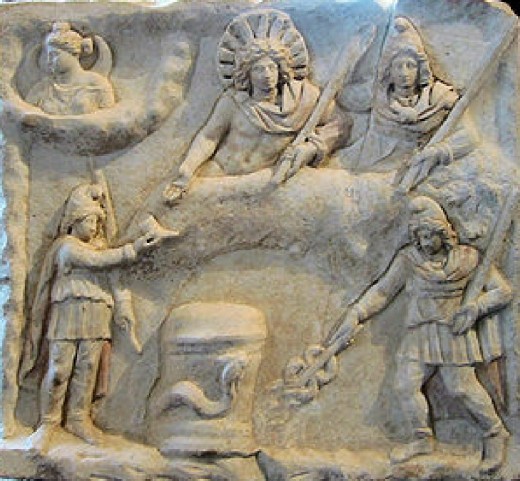
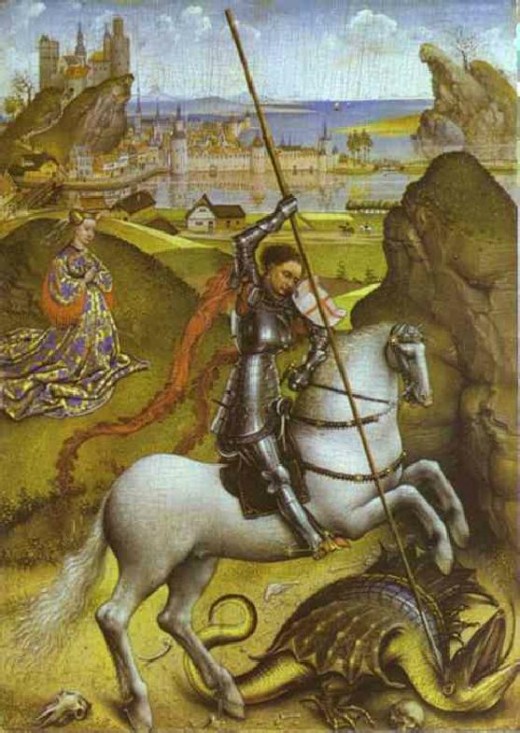
This gory ritual may-well have been outlawed by the old Church Fathers, but like most ancient religious practices it refused to go entirely away. The Bull became transformed.... into a Dragon!
Almost as soon as the victorious Sun-God, he that defeated death and is born-again, crosses the invisible-line and enters Taurus - we have a day that celebrates a dragon-slayer - St George's Day, on April 23 each Spring.
George sits atop a white stallion - symbol of the Sun, and now in his full strength, stabs it in the neck and spills its blood onto the Earth. In George's case - the young female was the personification of the Earth Goddess. George slew the dragon to save the King's daughter, while Mithra slew the Bull to save the Earth.....
But George wasn't always the patron saint of England though - his predecessor was an Anglo-Saxon King called Edmund, one of those fellas whose head kept on talking after the Vikings had lopped it off, and lobbed it into a hawthorn-tree, just for a laugh. His loyal-entourage, searching for headless-Eddy, heard a voice calling out, 'Here I am, up here in this tree.' A white wolf was guarding the tree, which then led the posse, carrying Edmund's talking-head, to the remainder of his corpse. Then they dug a grave and buried him and named that place Bury St Edmunds.
As you can see from the map/diagram (we'll come-back to this a bit later), during the month when the Sun rises in Taurus (as seen from The Hinge) it travels north into Suffolk, and rises over Bury St Edmunds!
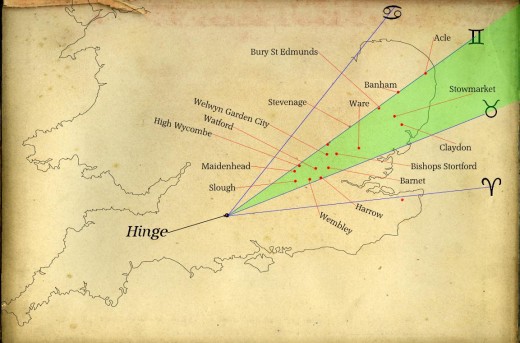
High Priestess
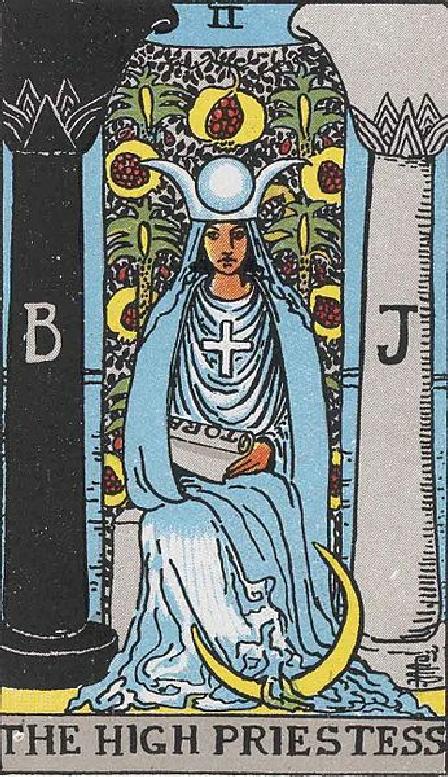
High Priestess
But before we investigate the alignment in any detail, let's just acquaint ourselves with the 'hidden' or occult influences of the sign and season as seen through the medium of the Taurean tarot arcana - the High Priestess and Heirophant. It's quite fascinating to me how these influences manifest 'out-there' on the wider-field - the world of humanity (not to mention the geography).
The card numbered II (2), High Priestess, relates to sign number 2 - Taurus. The High Priestess has already passed through most of life's experiences. She knows Reality. She is strict and demands adherence to the law. She is sometimes shown wearing the crown of Isis and Hathor; the waxing, full and waning Moon. She is usually shown, like the Hierophant, sitting between two columns, one black, one white. But unlike the Heirophant, she does not explore the world to master it, but to understand it. The pomegranates associate her with Persephone, the Queen of the Underworld - the Dying Goddess whose annual rebirth renews the world.
Heirophant
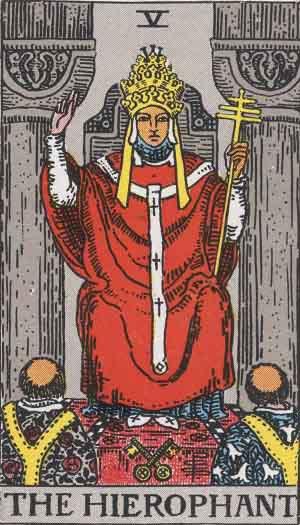
Heirophant
The other card influencing Taurus is called the Heirophant.
Heirophant's Keywords: education ♦ knowledge ♦ understanding ♦ study ♦ learning ♦deeper meaning ♦ belief systems ♦ cultural heritage ♦ religious tradition ♦ ritual and ceremony♦ discipline ♦ conformity ♦ rules ♦ orthodoxy ♦ convention ♦ the system ♦ going with the program ♦ the establishment ♦ group identity ♦ organizations ♦ institutions.
One and a half weeks after the Sun has entered the Earth of Taurus, and we've 'celebrated' St George's Day, we arrive at the cross-quarter festival of Beltane/May-Day, at which the sun-god Bel was, in ancient times, praised and propitiated. All old fires were put out, and Bel's sacred fire was created from the focused rays of the Sun. This sacred flame was carried to all the hearths in the surrounding area.
Beltane is may eve - high spring and burgeoning fertility, and like all Sun-Gods, Bel had manifestly won another great victory over the powers of winter, darkness and death by delivering the people to the new year - to enjoy another summer, and reap another harvest. Bullocks would be driven between twin fires for purification and fertility. Women desiring pregnancy would, whooping, calling and laughing jump over the fire.
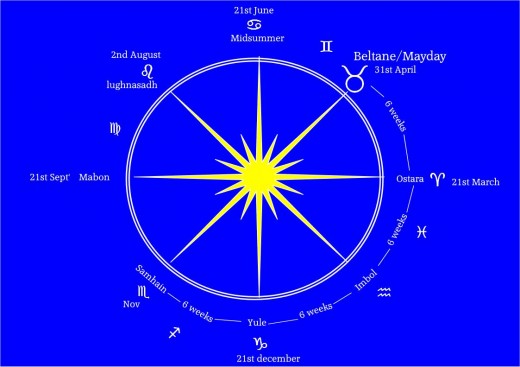
The Slough Stench
Returning now to investigate the map, you can see that I've picked just a handful of place-names that fall within the English Taurus zone out of the many hundreds (if not thousands) located there.
Let's start with the town of Slough. First-off, Taurus is an Earth-sign. Slough is where we get the word slurry - used as an organic fertiliser, to spread on the land and make nice things grow.
This from Dictionary.com Slough: An area of soft, muddy ground; swamp or swamplike region. Obviously, as we're in the sign of the Bull we might say that here, we're literally talking bull-shit.
The Slough sewage treatment works between junction 6 and 7 on the M4, often releases a stench that's detectable to drivers, a phenomenon known as The Slough Stench.
According to Wikipedia Slough has the highest proportion of religious adherents in England - I remind you of the influence of the Heirophant and High Priestess.
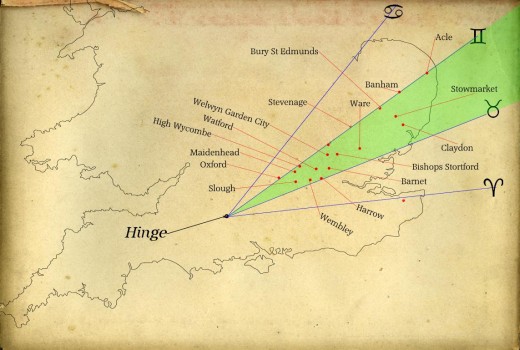
Whilst we're in the area we may-as-well look at the most obviously Taurean of them all - Oxford, a name that clearly implies a river-crossing where one may take one's oxen across. 'For'd' could also, of course, be the plough-man telling the oxen to move forward.
Between 1786 and 1854 there was a bell-foundry in Oxford .... I wonder if they made cow-bells? Bells are very Taurean things, you see. Bells have been cast in bronze, brass and gold - the metals of Venus and Taurus - for as long as man has made bells. Even today we understand the link between bells and religion easily enough - bells and timing of rituals, the call to prayer, the call to lessons - the right time for this and that - toeing-the-line as the Heirophant demands.
Taurus the bull is associated with metal-working in other ways too. The anvil itself is modelled-on a bulls-head and horn. The bellows are named after a bull's roar.
And of course, Heirophant's and High Priestesses have long favoured Oxford as a place to pass their knowledge on to others. There have been renowned universities and colleges here since time immemorial
Harrow On The Hill
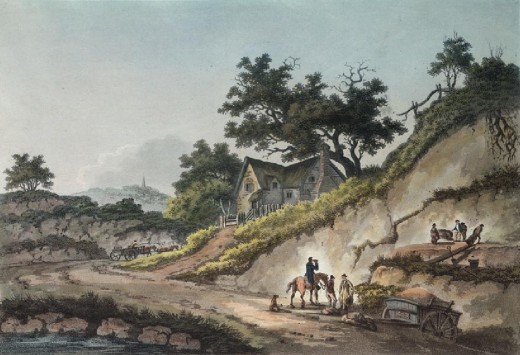
Next-up is Harrow - surely another reference to the Earth - for a harrow is a farming tool for breaking-up and smoothing-out the surface of ploughed earth - harrowing is done to break up clods and give a finer finish as good soil-structure for seed-bed.
However, Harrow is better-known for its school - at which point I remind the reader again that this sign Taurus is governed by the High Priestess and Heirophant. Keywords are: education ♦ knowledge ♦ understanding ♦ study ♦learning ♦deeper meaning ♦ belief systems ♦ cultural heritage ♦ religious tradition ♦ ritual and ceremony ♦ discipline ♦ conformity ♦ rules ♦ orthodoxy ♦ convention ♦ the system ♦ going with the program ♦ the establishment ♦ group identity ♦ organizations ♦ institutions.
Harrow on the Hill formed an ancient parish in the Gore hundred of Middlesex, first recorded in 767 as 'Gumeninga Hergae'. All I have to say about that name - Gore - is that that's what happens to incompetent matador's - they get gored.
Moving on then - Wembley is right in the zone. According to the experts the name means something like Wemba's Lea - a lea being a meadow or pasture - and that's where you keep your cows and bulls and it's also what they eat. On the matter of what you eat I should mention that the sign of the Bull - governing the throat and tongue, also governs the appetites, what we put into our belly via our taste-buds. Taurus is the sign of desire and is polarised with opposite sign Scorpio (sex), and is ruled by the planet of attraction and love - Venus - sexuality is also a marked feature of this sign. For what is fertility without sex?
Popping across the map a little we find an interesting place-name - Maidenhead. In physiological terms this is an old word for the hymen.
High Wycombe was first documented in 970, as Wicumun. The prefix 'wicu' means week, as in 7 days - and 'mun' the suffix is 'mund,' a bridegroom's gift to his bride. There are various ways to interpret such an odd place-name - but I think that the gift is probably the grooms wedding-tackle.... and that the gift-giving goes-on for a week.
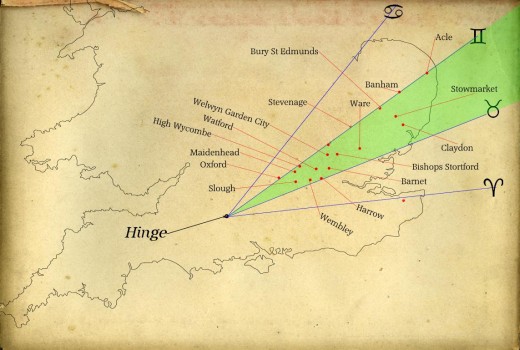
Watford - I had imagined previously that this probably means wet-ford, but checking the Anglo-Saxon dictionary I see that wet is not what 'wat' means at-all. 'Wat' is 'wita' and 'witan,' meaning philosopher, wise-man, sage, counsellor, elder, senator. Clearly then Watford is spelling-out the word Heirophant.
Welwyn Garden City is formed out of three old villages.
The Garden Cities and Town Planning Association has defined a garden city as
a town designed for healthy living and industry of a size that makes possible a full measure of social life but not larger, surrounded by a rural belt; the whole of the land being in public ownership, or held in trust for the community.
Anglo Saxon Dictionary


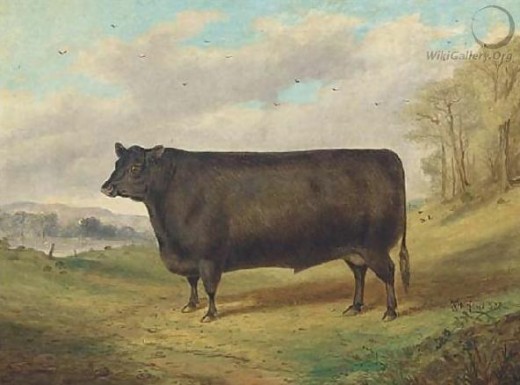
Well... that sounds pretty-much like a Taurean ideal, a cow contentedly standing in a pleasant meadow munching the pastures...aahh. I checked the dictionary: 'Wel' means what it looks like - well, abundantly, very, very-much, fully, nearly, for the most part, everywhere. The suffix 'wyn' is 'wynn' and that's joy, rapture, pleasure, delight, gladness, wine.
Barnet just happens to be one of the places where I stuck the pin in the map, like the others. It might be suspected that I've carefully selected these particular places, knowing that they'd fit the pattern to a 't,' but I tell you that that's not the case. These place-names we're looking-at were/are as randomly selected (within the zone) as I could make-it. So, on to Barnet then, recorded as Barneto around 1070.
The prefix 'bar' is actually a boar... and the suffix 'neto' was probably intended as 'nieten,' because 'nieten' means cattle. So Barnet means pigs and cows! What are the chances of that eh? I'm not making this up - to prove it I'll paste a cut from the dictionary just here (above right).
Interestingly named Bishops Stortford seems to immediately conform to the Heirophantic pattern - 'cos a bishop is a heirophant. But anyway, that's slightly irrelevant because it was first recorded as Esterteferd. Passage of time and the heirophant or bishop of London building his house or palace at Esterteferd gradually mutated it into its current name. We'll look then at the meaning of Esterteferd.
The prefix 'est' is grace, favour, bounty, love, kindness, harmony, consent, and even some delicacies. The second syllable is not so easy to interpret - 'ert' has no exact match that I can find. I have to say though that various near-misses seem to hit the mark when taken in context with all we've seen thus far. So 'erian' means to plough, and 'ernth' is a crop-of-corn. The point is that both these short words begin 'er' and relate to ploughing and harvest respectively.
Finally, the suffix 'ferd' is not a misspelling of 'ford,' for in Anglo-Saxon it means mind, intellect, spirit, soul, life, eternally, forever. Like wow!, that's some kind of place-name, and some kind of meaning..... grace/life/plough/consent/life/spirit/crop/bounty/love/eternity..... however you choose to put it together, it fits the pattern that's unfolding here in this Taurus and its rites of spring sector.
Moving on again, the next place-name I stuck a pin in is called Ware.
As far as I can tell, it's been called that since the beginning of time, or thereabouts. In our old tongue 'ware' is 'waru,' and that was an article of merchandise, as it is today. Well, a cow or bull was the utter epitome of ownership - it was a symbol of wealth. Cows did not, generally speaking, belong to peasants nor peasant farmers. Magical Milch cows which yield endless amounts of milk and cream have long been the centre and source of much lore and mythology. Dairy produce such as cream and butter have always been seen as luxury, 'feel good' foods and treats, and were always subject to special attention from Otherworld denizens who would curdle the cream, cause the butter to fail, or even steal the cow or bull, and whisk it away to the land of faerie.
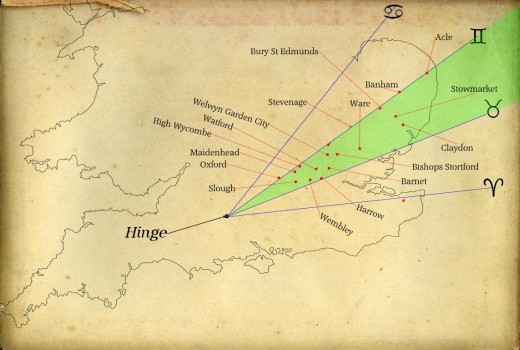
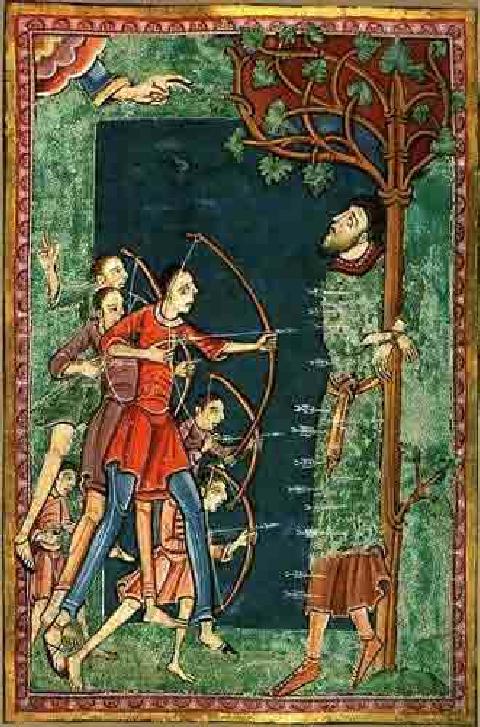
Stevenage was recorded as Stithenæce in 1060 - 'stith' means stout, strong, hard, while the suffix means oaks. I guess it's a reference to that old heirophant, and his unbending adherence to the rules, regulations and tenets?
We already know the meaning of Bury St Edmunds, we discussed earlier that the former Patron Saint of Olde Englande was filled with arrows and chopped-up by the Vikings, and buried here, the town named after him. Very little is known about Edmund 'cos the Vikings did the proper-nasty to Anglia after doing poor Edd. I can only guess then - based on the attributes of this Taurus sector - that Edmund was a wise man, a heirophant.
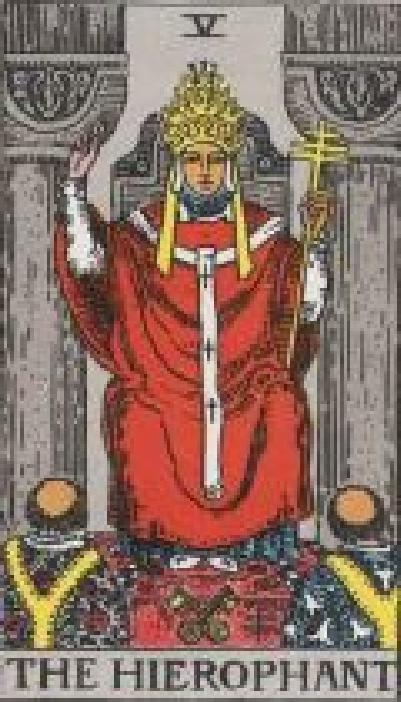
Claydon is also in the zone, and clay is Earth, and Taurus is an Earth-sign. I don't think I need to expand on that.
Moving on, let's look now at Stowmarket, which means pretty-much the same whether writ in old or new English: 'stow' means location, spot; the second part of the name - 'market' comes from the Anglo-Saxon 'marc,' meaning a denomination of weight (usually 1/2 a pound), and 'mark,' (money of account). Obviously then, Stowmarket was then and probably is now, the place to buy and sell things (a bi-weekly market is still held there on Thursdays and Saturdays).
Next door in Norfolk is Banham. There's a couple of different meanings associated with the word 'ban' and 'bann.' The first of these is bone, tusk, the bone of a limb, and second is proclamation, summons, indiction (cycle of 15 years).
Let's look at the first meaning, a bone/tusk... well, what can I say. Bulls have horns with which to gore. Not only that, cow bones have some interesting uses.
Somewhere here in East Anglia archaeologists uncovered - a few years ago - an ancient cow shin which had been hollowed out and stuffed with gold coins. They say that it was simply a practical consideration that led the ancients to the choice of cow bone, providing enough space within the hollowed out-bone for storage of the booty. But it's no coincidence that they chose a cow-bone, rather than a goat or horse for this purpose, understanding as they did the magical affinities of gold and cows, as we do.
The second meaning of 'ban/bann' - proclamation, indictment, summons fits the pattern of Taurus perfectly. Firstly because Taurus governs the throat and voice and a proclamation is issued via the voice. Secondly because such a proclamation or summons is issued by a priest or bishop (a heirophant) accompanied by the sound of bells (bulls?). In our 21st century understanding, a bann signifies only one thing - the announcement or proclamation of a church wedding - and here I'll remind you about some previous place-names we've looked-at: Maidenhead (hymen), High Wycombe (bridegroom's gift to his bride), Bishops Stortford (grace, favour, bounty, love, kindness, harmony, consent, delicacies).
As always in this weird landscape, the patterns that unfold as we scan the land are surprising at first - but always fit the pattern - and always teach me something new about the astrological influences that we are - collectively - immersed in. The landscape is my teacher.
Of course, underlying all of the above interpretations suggesting legal marriage and regulated love, its societal expression and acceptable behaviours as codified by the heirophant, is the theme that unites the ideas - fertility and procreation - Taurus.
The last-one I've marked on the map is the Norfolk village of Acle. This is a pretty straight-forward one - it means oaks. Oaks of course are the wisest of trees and very-much associated with druids - in fact the old word 'drui' means, literally, oaks. So this is a reference to the heirophant again.
Silly me, I almost forgot to mention the 'other' thing - the giant infant, England... brain like a sieve sometimes.
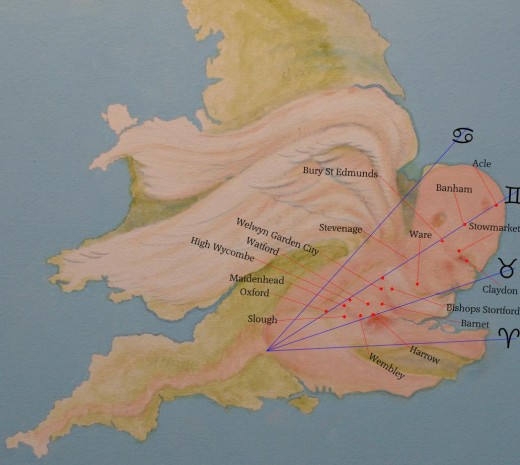
... and now, of course, there's a whole new lot of sense to make of the whole thing, when we take the physiology of the hermaphrodite, winged-one into account. If you follow the cusp-line of the Taurus alignment, from the hinge to the top of the infant's nose and head you can see it passes through his/her upper thigh muscles. Well that's a good place to have the strength of a bull or an ox, methinks. Then it passes through parts of the digestive system - I have to say that Taurus is beneficial here too - a cow has four stomachs and to have the earthy 'constitution of an ox' is no bad thing for the national-angel's guts. Slough is in those guts too - and while it made perfect sense previously representing fertiliser - it now makes even more sense, doesn't it? 'Cos we've all got that in our intestines, ain't we! Yes, I admit it - I am talking a load of old crap. Slough is in Middlesex - and given that our giant baby is a hermaphrodite, I think that THAT place-name speaks volumes, despite the experts verdicts on the borough's bisexual name. They say it means territory of the middle saxons. Well... all I can say about that is that, perhaps it does also mean that, but you'll understand if I stand-by my version of things? Warped as it is. Whilst we're here in Middlesex, I might as well throw-in this: the City of London was formerly a part of the borough, until they moved the boundaries again.
Any-road, Taurus is the sign that governs wealth, as well as food, and hence the stock-market; we saw earlier how markets feature quite strongly in this sign, for fairly obvious reasons.
Knowing what we do about the landscape gives us an insight into how things really come-about. Such as the stock-market term Bull Market - a Bull Market is associated with increasing confidence of investors, and increased investing because they anticipate price increases in the future (capital gains). A bullish trend in the stock market usually begins before the general economy shows signs of recovery.
Before quitting the Square Mile, as it's often-called, here's a wacky thought: why is it that a good belly-full of food is referred to as a square meal? I know it's nuts, but - given that the Square Mile is clearly inside England's Belly, and Taurus is all about good-food and the appetites in general, could it be that the phrase a square-meal came from the secret knowledge about exactly where The City of London - the Square Mile, happens to be? It's an interesting thought though - stock-market gains - gold - is our giant's nourishment; a good square mile.

Continuing up the torso, we see the alignment passes through our angel's biceps and shoulders - as I said above regarding the upper thighs - to have biceps and upper torso conditioned by the influence and strength of the Bull is no bad-thing, I'm sure - this infant is as strong as an ox in both legs and arms.
After that it passes directly along the length of our angels throat - what are the chances of that eh? Taurus rules the throat and voice - you couldn't make this stuff-up. The ruling planet Venus is beautiful - our giant cherub's voice would then be sweet, soothing, musical.... and the actual words themselves, formed in that throat and cast-forth into the aethers would speak the language of diplomacy and sing peace, love and wisdom.
The main-alignment leaves the giant's face at the nose.... and it's by a ring in the nose that a Bull is controlled, steered. But how fortunate is it, that the line of Taurus and beautiful Venus should cast their lights onto our national angel's throat and facial features?
I believe it's fortunate for us too - because what happens to and within our landscape baby's macrocosmic physiology, affects OUR microcosmic forms - OUR physiology, OUR minds. I believe therefore that the British are a blessed people - but I don't know how any of this came-about. Only that it did.
But now it's time to look at the other wheel, the one that affects the whole globe, pivoted and cantilevering from the giant's ankle in Canterbury.
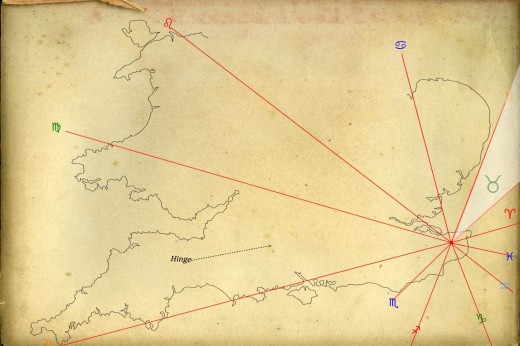
From up in the sky Kent, the weald, looks (to me) for all the world like a great-big bull's (or cow's) head with a blade sticking out of its throat (otherwise known as Dungeness etc). Crazy huh? I mean, those old Bull worshippers would've had a field-day with it, wouldn't they?
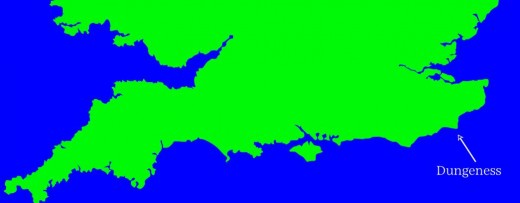
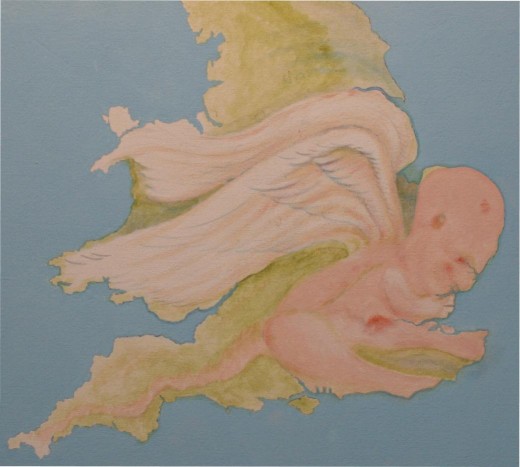
And yes, though Kent and East Sussex are indeed a winged hermaphrodite's outstretched-legs - as I've shown - I'm now asking you to shift your imagination into another gear and see Kent and East Sussex as a Bull's head with a blade sticking-out of its throat.
Think about it.... leg-muscles and calves. I mean, why are those lower leg muscles called calves? Huh? And then how about Kent also being called the Garden of England, 'cos as I've had a go at explaining, this Taurus vibration is all about gardens, may-day, flowers, trees and fertility - so the moniker Garden of England is ever-so-slightly appropriate.
Kent and parts of East Sussex have also been known, and still are known as The Weald. When we look at that word in the Anglo-Saxon dictionary we get several interpretations: grove; power, might, control, exercise.
Does that sound like a description of a powerful Bull? Or a powerful pair of legs? Or both? Even the word grove suggests both druids (heirophant) and bulls, as it was in the grove that bull-sacrifice was carried-out.
And given also that Taurus and Bulls are the ancient signs and symbols representing wealth, then the fact that Kent has always been the wealthiest county in Britain and that it was/is the centre of secular and non-secular power are better understood (London was a part of Kent until 1889 when it became a County in its own right).
Raging Bull
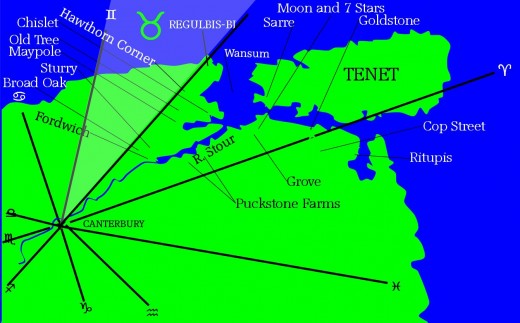
Pliny the Elder describes the ancient goings on the groves, in his Naturalis Historia (XVI, 95):
Anything growing on those trees [oaks] they regard as sent from heaven and a sign that this tree has been chosen by the gods themselves. Mistletoe is, however, very rarely found, and when found, it is gathered with great ceremony and especially on the sixth day of the moon... They prepare a ritual sacrifice and feast under the tree, and lead up two white bulls whose horns are bound for the first time on this occasion. A priest attired in a white vestment ascends the tree and with a golden pruning hook cuts the mistletoe which is caught in a white cloth. Then next they sacrifice the victims praying that the gods will make their gifts propitious to those to whom they have given it. They believe that if given in drink the mistletoe will give fecundity to any barren animal, and that it is predominant against all poisons.
So, I guess that as Taurus is THE Earth-sign of the zodiac, that is, it's the 1st Earth sign and represents the Earth itself, then, Kent in particular but the land of Britain as a whole, is governed - zodiacally governed - by the sign Taurus, for reasons that seem pretty obvious. So while Taurus, like the other signs, has a definite 'cone of influence' as we project it out onto the wider global landscape, on the more local-scale of North Kent it won't stay within the bounds of that cone. It refuses. As you'll see in a moment, it spreads out quite a bit on either-side and all around the confines of the Taurus 'bull-pen.' But that's the nature of cows, bulls and oxen - they're large - and they love to wander about in the pastures.
So... on the more-local scale, in the environs east and north east of Canterbury (canter: a fast-trot), bovine-forms in the local-landscape are no problem to find at all.
There's the now waned-away Wansum Channel which once took the unmistakable form of an animal - (a bull?) - with an outstretched foreleg - the fore-leg known since time began as the River Stour. In livestock circles the word for a young cow or bullock was and is a 'steer,' which itself came from the word for 'star.' Steer and star are intimately related words because before GPS guidance, stars were what you were guided by - you steered by the stars.
Stars and Steering are related to bulls because bulls and oxen were employed as tractors to pull the plough and harrow, and that meant they had to be steered in straight-lines up and down the field. And that's why a young bull was called a steer.
But before a bull can do the job it has to be taught to behave itself - it had to be steered, disciplined, trained. The steers learned to steer straight, by the steers (stars). Interesting then is the fact that in Anglo-Saxon the name of the river, the Stour, means both star and steer.
Nearby Sturry has the same roots as the Stour and means starry. Which is interesting in itself because the constellation Taurus contains the pleiades or seven-sisters and is indeed, very starry.
Anglo-Saxon dictionary Steor
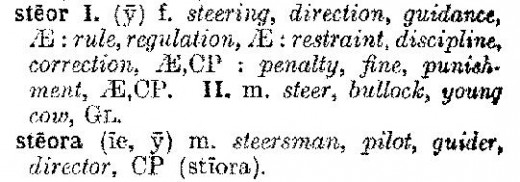
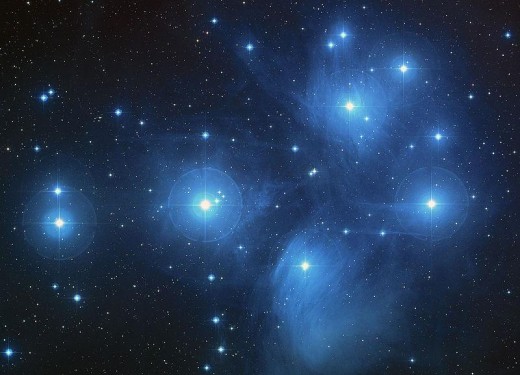
The ancient village of Fordwich - right there at the 'hoof' of the foreleg - used to be called (and I'm not making this up) Forewich.
This bull in the landscape would have been pretty central to the lives of the ancient inhabitants of this land - had they known about it. 'Cos obviously, they couldn't have, could they? I mean, they'd have needed an aerial photo and that's something we all know they couldn't have had. So this is all conjecture on my part, nothing more than that. There is simply no-way our ancient Briton's could have acquired a birds-eye-view of the landscape of North East Kent.
So we just have to accept the idea that coincidence is king in the land of the rational-mind - because jeez-uz-h-christ there's some weird coincidences happening all-over the place on the landscape around Canterbury and Thanet.
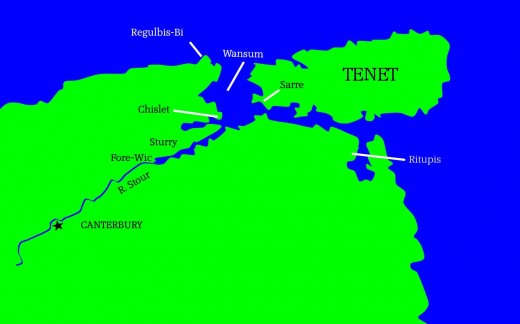
How about these for coincidences.... I find reference to ritual bull-sacrifice all around. Look at the location of the village called Chislet - positioned in the throat of the bull. Chisel it is the message, a chisel being a sharp tool for cutting into things.
On the island there's the village of Sarre - and that looks like the back of its neck - and the word 'sarre' means to cut or saw and also has the other meaning sore, as in ouch, that's painful. Running through the village of Sarre is a small stream with the name Sarre Pen. I have to tell you that in our old tongue 'pen' would be 'pin' and 'pin' means nothing but pain. So the village's little river's name means sore pain.
There's the village called Gore on the Thanet Isle, and across the isle there's another called Gore End, speaking of both the mess that bull-sacrifice makes, blood and gore, as well as to what happens to a careless matador.
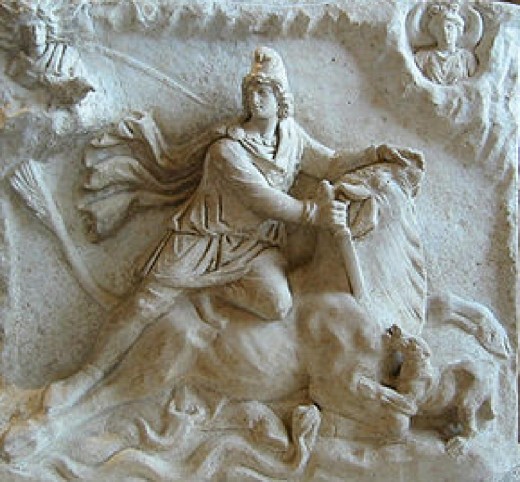
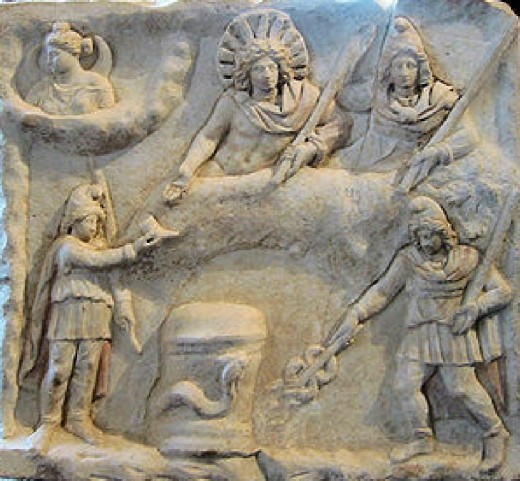
Regulbis Bi
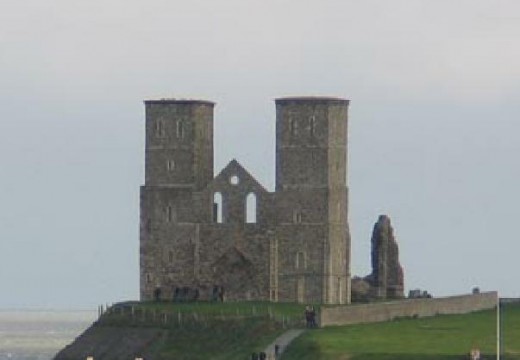
But it's not just bull-sacrifice to be found writ-large on the face of the landscape. There's money and heirophants and groves.
I haven't marked them on the map but at the southern end of the Wansum is an ancient drainage channel aptly named Silver Dike, and that's not very far from Farthings Wood, Taurus is ruler of all things financial. On the opposite horn at the northern end of the Wansum Channel stands the ruin of Regulbis-Bi - Reculver Towers in modern English. Where there is now a sea wall and the sea, there was once seven acres of land and, according to archaeologists, the Imperial Roman Mint! They manufactured coins here.
Back at the southern end again, was the Roman temple Ritupis, that's 'rite' and 'pis,' or fish. It was here that archaeologists discovered a carved stone with Ogma - the druidic Mithras - depicted on it. Regulbis and Ritupis stood at either end of the Wansum crescent (wane-sum, like the Moon) and represent - I avow - the be-capped torch-bearers in the Mithraic scene, representing the Equinox's.
The theme of discipline or steering makes itself known here too. The name of the towers Regulbis Bi is an astronomical reference to the star Regulus - source of the words regal and regulate - that is - steer. Very interesting then is the fact that, after the Romans left these lands, the king of Kent took over Regulbis and made it into a palace, and from here the king regulated the kingdom of Kent. It later became one of the first schools in England, alternating its role between palace, temple and school until it fell into disrepair and ruin a century or two ago. At one time this now almost deserted area around Reculver was the most populated parish in North Kent - there was money here.
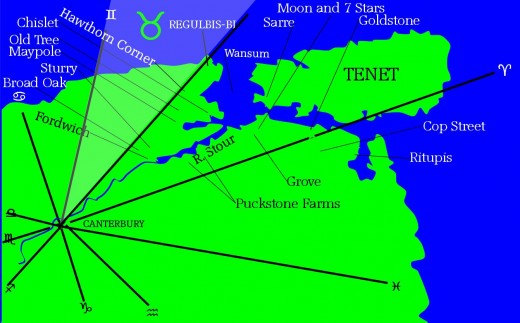
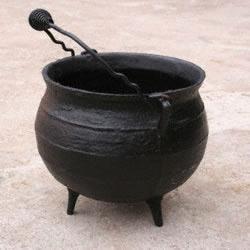
By now there should be no need whatever to tell anyone why the village called Grove is so appropriate.
Nor why a place named after priests or heirophants takes my-eye. Preston village is very ancient and very beautiful, me and my dad fixed the old peg-tile roof on the sprawling old priory there, 20-odd years back. 'Prest' is the old spelling for priest, and of course priests and heirophants are the same thing - or were. Every lunch-time we went and had a few ales at the local pub - with a very old name - The Half Moon and Seven Stars.
Taurus is home of the seven-sisters and is co-ruled by the Moon. At starry Sturry, there's a street on a small estate known as Pleydell Crescent. The 'crescent' is, I think, reference to the Moon and 'pley' of Pleydell means pleiades - or my uncle's a monkey. The streets adjoining the crescent are all named after trees: Cedar, Rowan, Babs Oak, Laburnum and Chestnut. The connecting A-roads are named after the ancient groves which the houses now replace, Homewood, Wildwood, Hoadswood and Hawes Wood.
Wickhambreux: the experts tell us this means place of a brew house, and maybe it does. It’s just that, being so close to all the 'pagan' place names around-here - such as Maypole, Grove, Old Tree, Broomfield, Half Moon and Seven Stars etc etc, failure to suggest witches brewing-up stuff in cauldrons might be seen as slapdash. This is not too outrageous a suggestion - 'wicce' means witch after-all, and 'wiccian' is to use witchcraft - and 'wica' means wizard, magician, soothsayer and astrologer.
Broomfield is first noted as Brunfelle in the Domesday Book. Broom used to be considered a sign of plenty, bearing many flowers. The besom-broom, the archetypal witches broomstick, is a spring-cleaning tool, and like sage, was burned for ritual purification. It was employed by the herbalists as a medicine.
diabolical dancing
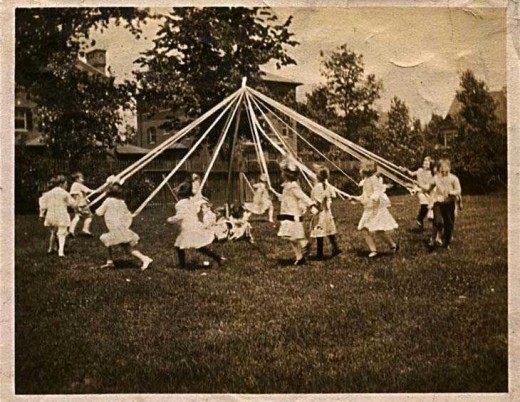
Ouen's “Vita of Eligius” (7th Century) spoken to his congregation:
Diabolical games and dancing or chants ...will be forbidden. No Christian will do them because he thus makes himself pagan. Nor is it right that diabolical canticles should proceed from a Christian mouth where the sacrament of Christ is placed, which it becomes always to praise God..... Venerate no creature beyond God and his saints. Shun springs and arbors which they call sacred. You are forbidden to make the crook which one you should burn it with fire. For you must believe that you can be saved by no other art than the invocation and cross of Christ. For how will it be if groves where these miserable men make their devotions, are felled and the wood from them given to the furnace? See how foolish man is, to offer honor to insensible, dead trees and despise the precepts of God almighty. Do not believe that the sky or the stars or the earth or any creature should be adored beyond (other than not more than) God for He created and disposes of them all.
bull's horn
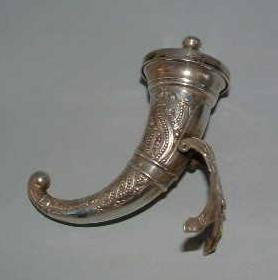
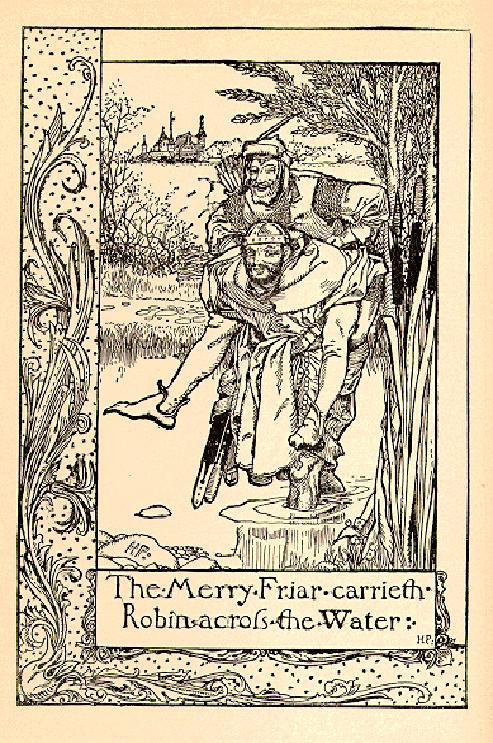
There's a village called Goldstone - gold is Taurus. There's a tiny village called Cop Street - 'cop' is Anglo Saxon for 'cup,' and 'cup' meant 'cornucopia,' or 'horn-of-plenty,' a hollowed-out bulls-horn filled to over-flowing with mead, or fruit - symbolic of the good-things in life - wealth and plenty. There's the village of Maypole, and another called May Street. At Maypole village is the settlement called Old Tree.
Then there's the village called Worth and another called Guilton, meaning gilt (gild, geld, gold). Then there's Poorhole Lane, and Beggars Corner - wealth and its opposite state are both governed by Taurus.
Beltinge, on the coast a couple of miles from the towers of Reculver is named, I believe, after the may-eve cross-quarter day Beltane.
Along Shottenden Road on the way into Margate is a large farm called Puces, Puce is just one of the old ways of writing that woodland sprite's name, Puck, as were Phouka, Pooka, Puca and Puca. He's referenced all over this area of the landscape - Plucks Gutter, Little Puckstone Farm and Greater Puckstone Farm.
Puck was also known as Robin Goodfellow - he generally lives with the animals in the forests existing on shoots, grasses, leaves and berries - he's a shape-shifter, can become a horse and lead you on a wild ride, dumping you in the water. He's a rough, hairy goblin - some stories have him as an old man, like a brownie or hobbit, like Pan from Greek mythology, as a silver-haired elf, and like an innocent child. Puck’s behind the wil o' the wisp, as he would lead travellers with a flickering lantern and then blow it out when they were at the edge of the Wansum Channel, the Stour, or one of the many swamps in the marshes, or even the cliff, giving his laugh of ho ho ho! Such misadventures were described as being ‘Puck-led.’
Puck shape-shifted and emerged as Robin Goodfellow, and he transformed into Robin Hood. Robin, as you know, lead a band of outlaws who hid in the Greenwood, and help the powerless peasants to reset the balances more in their favour. Wealth and its redistribution to the poor were behind the Hood's popular appeal, and probably account for his name appearing in these North Kent place-names far removed from Nottingham, his alleged stomping ground.
Clues that suggest this legendary character's presence in the vicinity are abundant - at the village of Hoaden, for instance, 'hoaden' meaning hooden, to wear a hood - not forgetting Hoads Wood - Hood's Wood, no less.
The etymology of 'hood':
Hood: from O.E. - had 'condition, position.' Originally a freestanding word, cf. O.E. hed 'position, dignity', O.N. heiðr 'honour, dignity,' it survives in Eng. only in this suffix.
‘Head’ of course, is of the signs Aries and Taurus, signs of the will and desire.
The sheriff of Kent held court at Monkton, not far from Pluck's Gutter. Monkton is Monk's Tun and like Preston and its priests these monks are heirophants.
The 'great oak' under which the band gathered is boldly printed on the map, at the aforementioned village of Old Tree. In the old tales concerning Robin, his character is a lot more Puck-like than recently painted. During the 1700’s he was portrayed in ballads as something of a foolish or comical character - a buffoon who would ultimately - in spite of himself - win the day. In The Tinker, the sheriff's man sets out to capture the ‘simpleton’ Robin with an arrest warrant, manages to lay hands on him and is then cheated by Robin out of all his money and the warrant - and gets a sound thrashing into the bargain. Robin cheats priests and friars out of their cash, and even when he’s been beaten fair and square, he tricks his captor into letting him play a tune on his horn. This of course summons the hoods, and Robin’s away again, hurrah! Even the wilier ones who confiscate the horn are persuaded to have a little ‘consolation tipple’ with him, and end-up legless - Robin’s a champion guzzler, and before you know it, he’s off again, hooray! Beggars Corner is another little clue, as Robin often appeared disguised as a beggar.
And there's this, copied and pasted from Wikipedia: Robin Hood is famous for robbing the rich to provide for the poor and fighting against injustice and tyranny. His band consists of a ‘seven score’ group of fellow outlawed yeomen.
You'll probably remember from the previous article that Seven Score is a small hamlet on Thanet.
Well - I only know what's written there. I didn't put those words there on the landscape. Did Robin Hood really ever live in Hoads Wood, and did they gather beneath Old Tree in Maypole Village? Maybe my imagination's running-away with me again.
Though we could spend a great-deal more time looking at the map and discovering many eye-opening things, I've actually got to get a move-on with this. So about now we'll have to zoom-out and extend the Taurus cone of influence out across the globe. I'm always surprised at how the influences as seen here in Britain play-out when expanded to their full-extent - out there. I feel sure before I even look, that the same will be true of Taurus.
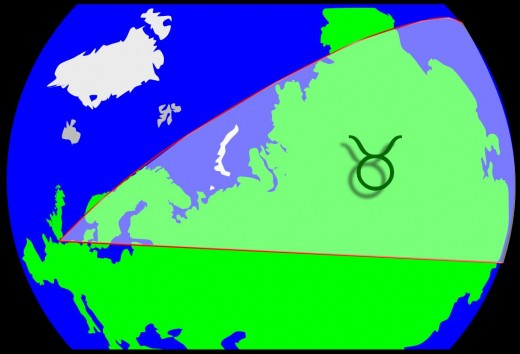
And yes - there it is straight-away. The 'beam' coming out of the bull's-eye of Canterbury, Kent, heads east-north-east across the North Sea and the first land-form the beam illuminates is Scandinavia. Scandinavia looks for all-the-world like some creature..... a bull perhaps?
Norway, Sweden and Finland are the nations within the bull.
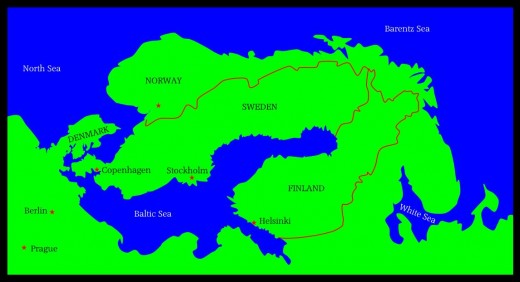
Denmark
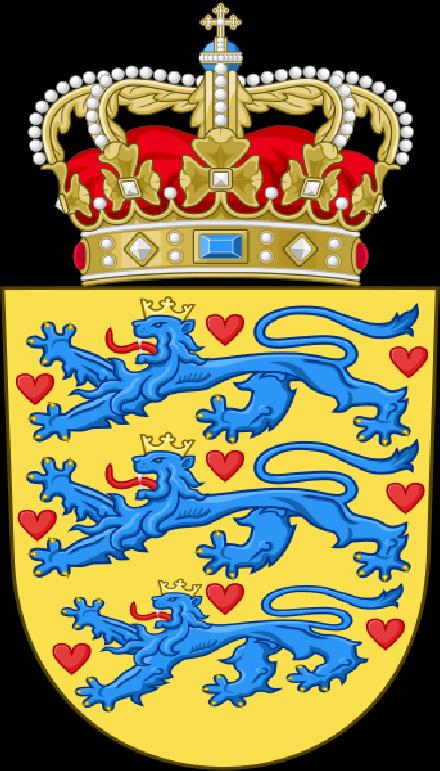
And Denmark is the large, unmistakably blade-shaped peninsula, jutting-out towards the exposed throat of the bull - Jutland is the incredibly appropriate name of the blade. There are many other islands - Zealand, Funen, Lolland, Falster and Bornholm, as well as hundreds of minor islands, together known as the Danish Archipelago.
I just want to mention this... at the farthest-reaches of this Taurus cone of influence, which is the other-side of the globe, we find situate there a land known as New Zealand. That's interesting to me as here we have Old Zealand and New Zealand coming under the same influence of Taurus, Heirophant, High Priestess, May-Day, rites of spring etc etc. In fact, when you look at where the Taurus cone of light actually falls - China, Mongolia, Japan etc, it's hard to imagine, at this early stage, how that might possibly work-out on the ground, if you know what I mean?
According to the mythology, Denmark was named after a bloke called Dan. The Chronicle of Lejre written about 1170 tells of a King of Uppsala (Sweden) whose three sons were Dan, aftyer whom Denmark was named, Nori who ruled and named Norway, and Østen who ruled and named Sweden. The second part of Denmark's name, 'mark,' is a bit of a mystery, but keeping with the context established previously, I think it probably has something to do with 'marc,' as found in various 'market' towns in England, and the London stock-market. Back there at Stowmarket we read it to mean 'marc,' a denomination of weight (usually 1/2 a pound), and 'mark,' (money of account). So... going the whole-hog and interpreting Denmark entirely into olde English, then the prefix 'denn' is a swine pasture - and that fits the pattern quite nicely.
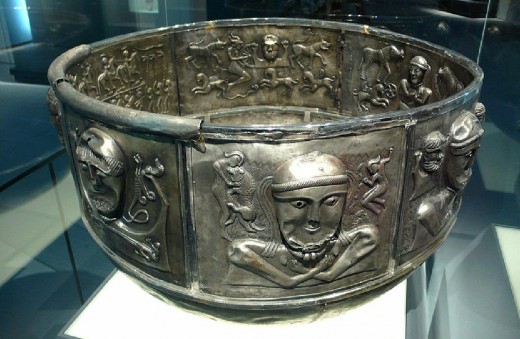
Priestess
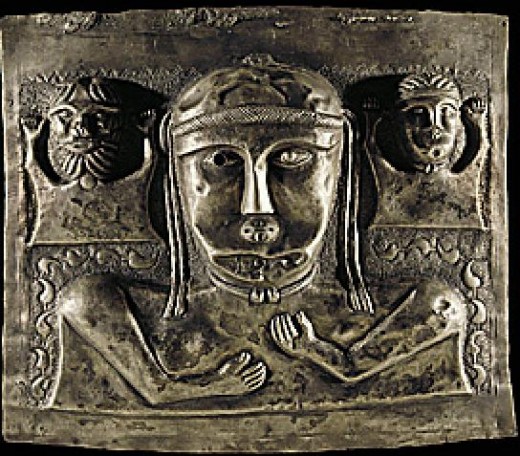
Heirophant
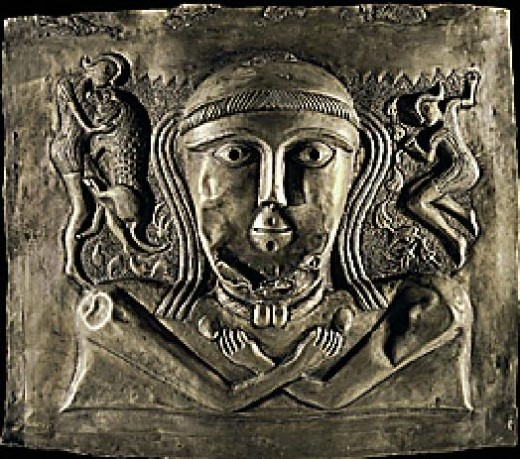
Another thing that fits the pattern is the amazing Gundestrup Cauldron, which was found in Denmark.... scholars debate what the images actually mean, but I have to interpret in terms of the Taurus zone and its influence. The cauldron is covered in images of bearded male figures and several prominently-placed females, which for me suggests the heirophant and the priestess. But, for me, it's the circular base-plate.... it depicts a bull. Above the back of the bull is a female figure wielding a sword and two dogs, one over the bull's head and another under its hooves. These are scenes very reminiscent of the Mithraic and Oghamic scenes discussed earlier.
From the 8th to the 10th century, the Danes together with Finns, Norwegians and Swedes, were the much-dreaded Vikings, and raided (and traded-with) all parts of the globe. They sailed east as looters, traders, colonists and mercenaries, in dragon-headed longships to Constantinople (Istanbul) and Russia, and west to Britain, Iceland, Greenland and Canada.
The popular ideas about the Vikings may well be based more on 19th century fiction and Hollywood movies than on the actual facts - but in my mind when I think 'Viking' I always picture them wearing a steel-helmet with bulls-horns on. I can't help it, even if it ain't true. The simple fact that that's how most of us imagine them, makes it real-enough in the world of the archetype. I mean, see a ship-load of hairy faced men with cow-horns sticking out of their head and you'd feel a little cowed.
To 'cow' someone is to subdue, restrain, or overcome them by affecting them with a feeling of awe and fear (as with threats).
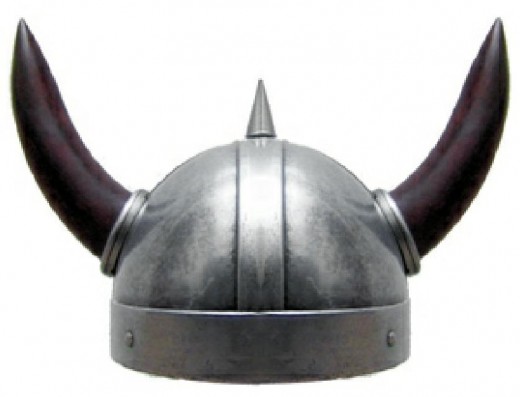
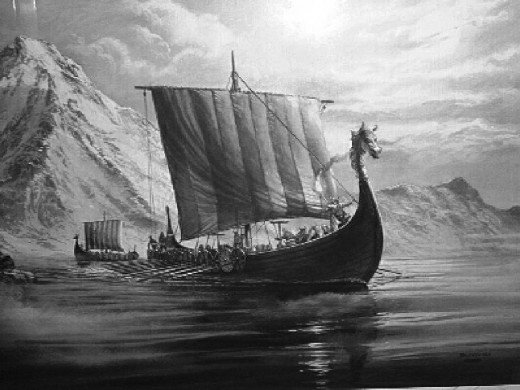
In the wild, cattle are a herd-animal that, ever in search of fresh herbage, continually yet slowly move from place-to-place - I say that's why the Scandinavians were such persistent travellers, acting-out the Taurean archetype and ever looking for fresh pastures. And this is where steering, stars and steers come back-in to the picture.
On a ship the steering is controlled by a tiller - 'tiller' is another word for plough. The rudder itself is based on the plough-share and a ship cuts furrows - it ploughs through the waves. The crew would imagine themselves to be in the belly of a steer (not a dragon) ploughing a furrow in the sea-pastures - a steer with a dragons-head! And of course they are navigating - steering - by the steers (stars).
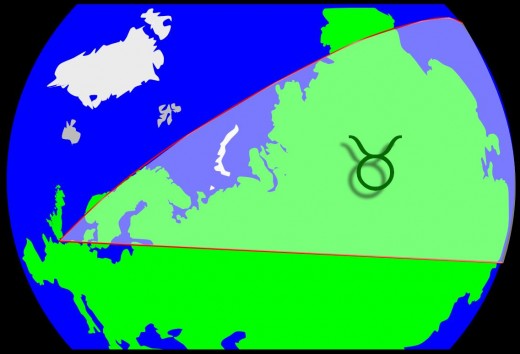
Norway
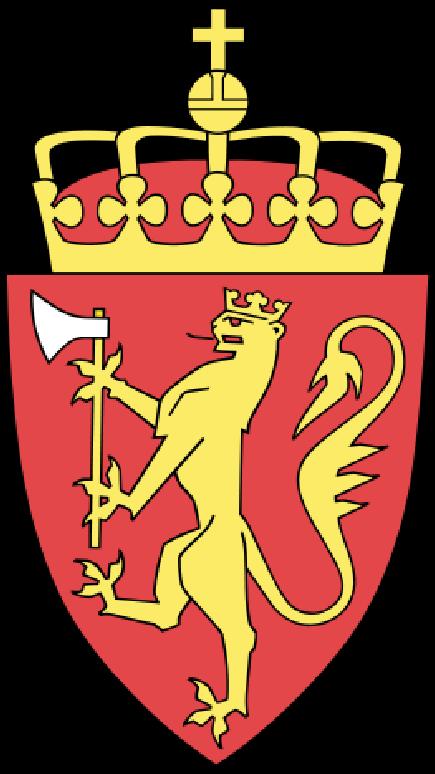
Sami Family 1900
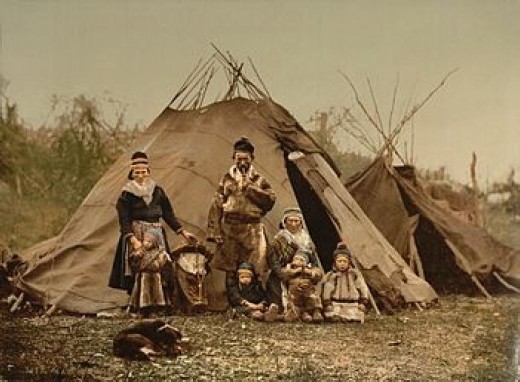
Sami fisherman 1884
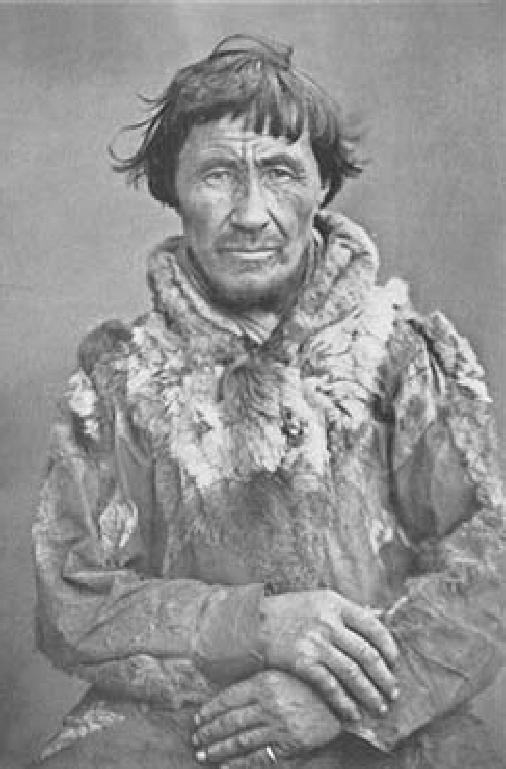
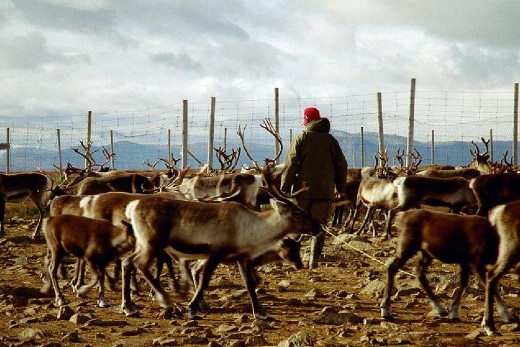
The blade of Denmark is slashing the throat of the Scandinavian-bull - and that's Norway.
To us softy southerner's Norway's environment seems too harsh for cattle or agriculture - but they manage it somehow - and always have, according to the signs they left behind. Archaeologists have found stone foundations of 5th century farmhouses 90 feet long - one was 150 ft in length. They were farmsteads where several generations lived together, with people and cattle under the same roof. But these were settlers to the area, not the natives.
The only indigenous people inhabiting the Arctic are the semi-nomadic Sami - their ancestral-lands are called Sápmi and includes Sweden, Norway, Finland and North Russia, an area roughly the size of Sweden. They have inhabited the northern arctic and sub-arctic regions of Scandinavia and Russia for at least 5000 years, and possibly much longer.
The Sami survived - and, amazingly still do - by fishing, fur trapping, sheep herding and reindeer herding. Amazingly because, between 1900 and 1940, Norway invested considerable money and effort to wipe out Sami culture. But Norway wasn't alone in this genocidal-effort - Sami women were forcibly sterilised by Swedish authorities, for example. The Norwegian parliament passed the 'native-land act' to allocate the best Sami lands to Norwegian settlers, and Sami language was outlawed in schools. After World War II, the pressure was relaxed, though the legacy of denial of Sami rights (to their beliefs, language, land and the practice of traditional livelihoods) was evident into recent times, such as the 1970s law limiting the size of any house that Sami people were allowed to build. As a result of all this pressure many Sami are now living in the Urban environment - though a substantial number still live in villages in the high arctic. The Sami are known for their highly spiritual songs called Joik - one of the longest living music traditions in Europe, comparable in style to Native American chanting. A joik has short lyrics or no lyrics at all, is deeply personal or spiritual and is dedicated to and attempts to evoke a person, an animal or a landscape - its personal signature. It is most often chanted a cappella.
They are currently experiencing cultural and environmental threats - oil exploration, mining, dam building, logging, climate change, military bombing ranges, tourism and commercial development.
In 1990 Norway signed-up to an international law that gives a 'special' status to the Sami. It states: It is the responsibility of the authorities of the State to create conditions enabling the Sami people to preserve and develop its language, culture and way of life.
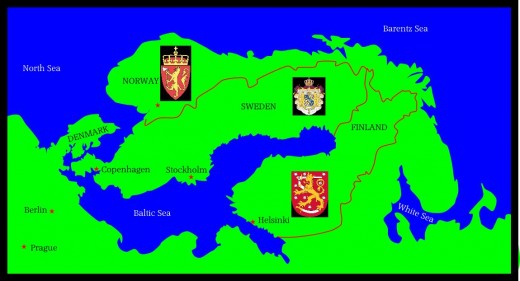
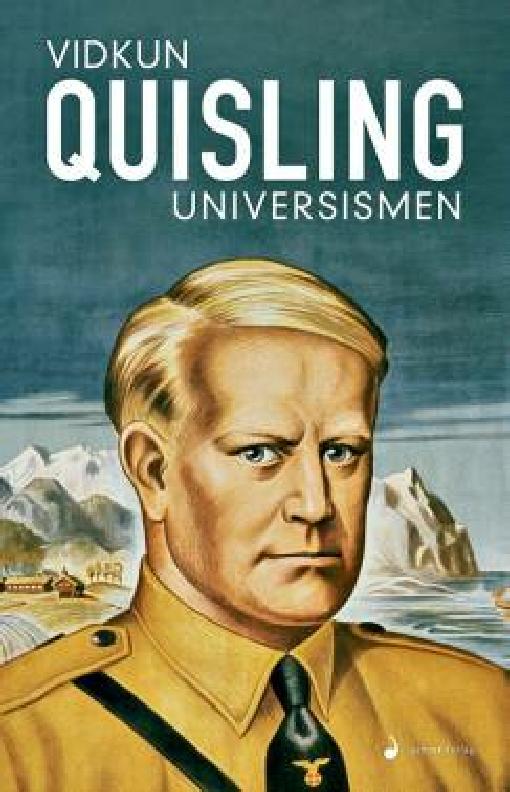
So, while Norway's current crop of politicians are decent types (one assumes), there have been a few dodgy gits hailing from there.
Norwegian politician Quisling's name has become a synonym for traitor.
Vidkun Quisling was a major in the Norwegian army, and defense minister in the government 1931-1933. Germany invaded Norway on April 9, 1940, and while the invasion was in full progress, he seized power in a Nazi-backed coup d'etat, becoming the first person in history to announce a coup during a news broadcast, declared an ad-hoc government, and worked with the occupying Nazi's on their 'final solution.'
At the end of the war and the defeat of Nazism, he was arrested, tried and found guilty of charges such as embezzlement, murder and high treason - and was executed by firing squad.
I've copied this article from Wikipedia:
The 2011 Norway attacks were two sequential terrorist attacks against the government, the civilian population and a Workers Youth league (AUF) run summer camp in Norway on 22 July 2011.
The first was a car bomb explosion in Oslo within Regjeringskvartalet, the executive government quarter of Norway, at 15:25. The bomb was made from a mixture of fertiliser and fuel-oil and placed in the back of a car. The car was placed in front of the office of prime Minister Jens Stoltenberg's and other government buildings. The explosion killed eight people and injured at least 209 people, twelve of them seriously.
The second attack occurred less than two hours later at a summer camp on the island of Utoya in Tyrifjorden, Buskerad. The camp was organized by the AUF, the youth division of the ruling Norwegian Labour Party (AP). A gunman dressed in a homemade police uniform and showing false identification gained access to the island and subsequently opened fire at the participants, killing 69 of them, and injuring at least 110, 55 of them seriously; the 69th victim died in a hospital two days after the massacre. Among the dead were personal friends of Prime Minister Jens Stoltenberg and the stepbrother of Norway's crown princess Mette Marit.
Sweden
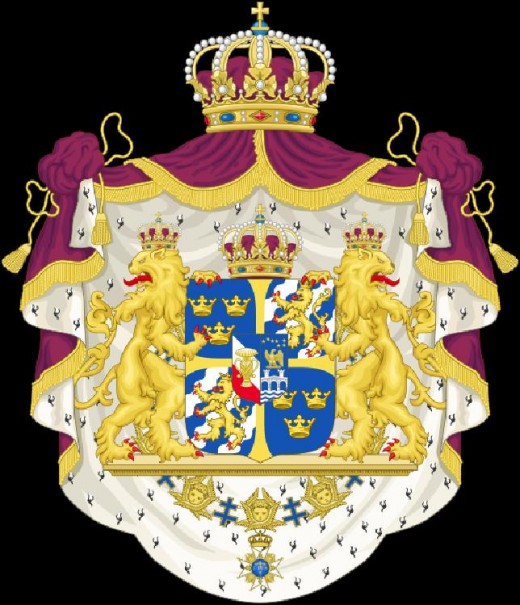
Sweden... Swedish Vikings (known as the Rus) travelled east and south, going to Finland, the Baltic countries, Russia and as far as Baghdad.
I have seen the Rus as they came on their merchant journeys and encamped by the Itil. I have never seen more perfect physical specimens, tall as date palms, blond and ruddy; they wear neither tunics nor caftans, but the men wear a garment which covers one side of the body and leaves a hand free. Each man has an axe, a sword, and a knife, and keeps each by him at all times. The swords are broad and grooved, of Frankish sort. Ibn Fadian (Arab traveller)
This from Wikipedia:
During the early stages of the Scandinavian Viking Age, Ystad in Scania and Paviken on Gotland, in present-day Sweden, were flourishing trade centres. Remains of what is believed to have been a large market have been found in Ystad dating from 600–700 AD. In Paviken, an important centre of trade in the Baltic region during the 9th and 10th century, remains have been found of a large Viking Age harbour with shipbuilding yards and handicraft industries. Between 800 and 1000, trade brought an abundance of silver to Gotland, and according to some scholars, the Gotlanders of this era hoarded more silver than the rest of the population of Scandinavia combined.
During the 17th century Sweden emerged as a European great power. Before the emergence of the Swedish Empire, Sweden was a very poor and scarcely populated country on the fringe of European civilization, with no significant power or reputation. Sweden rose to prominence on a continental scale during the tenure of king Gustavus Adolphus, seizing territories from Russia and Poland-Lithuania in multiple conflicts, including the Thirty Years War.
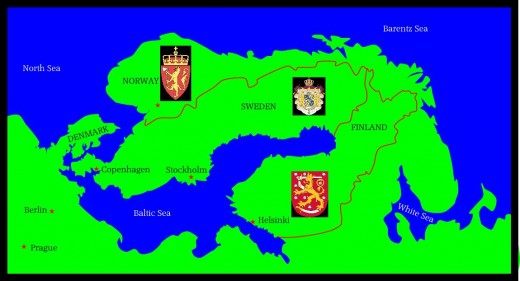
Finland
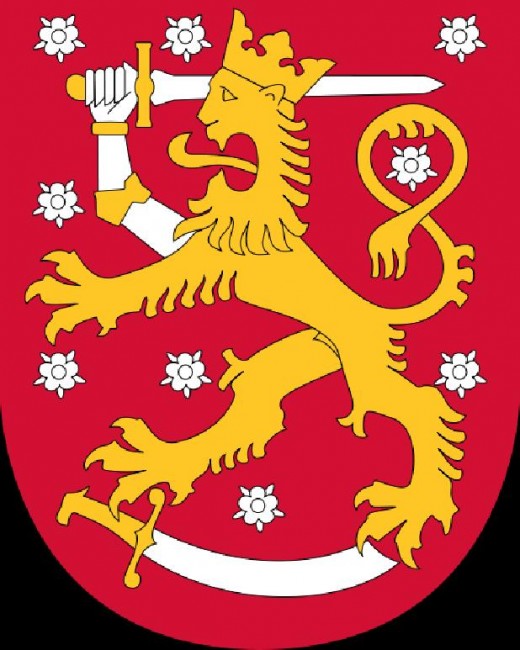
Finland was a part of Sweden from the 12th to 19th century, and from 1809 to 1917 was an autonomous Grand Duchy within the Russian Empire. The Finnish Declaration of Independence from Russia in 1917 was followed by a civil war in which the red side was defeated with German support.
In terms of wealth and stability and standard of living, all of the Scandinavian nations do pretty-well, as you might (or not) expect on a landscape shaped like a bull, bathing in the ray of Taurus emanating from the bulls-eye-cum-ankle of a giant winged baby called England. Finland ranks as having the12th highest per-capita GDP in the world, behind Sweden in 8th position, Denmark in 7th and Norway, which has the 3rd highest standard of living in the world.
Not only that, Finland is ranked the second most stable country in the world, in a survey based on social, economic, political, and military indicators.
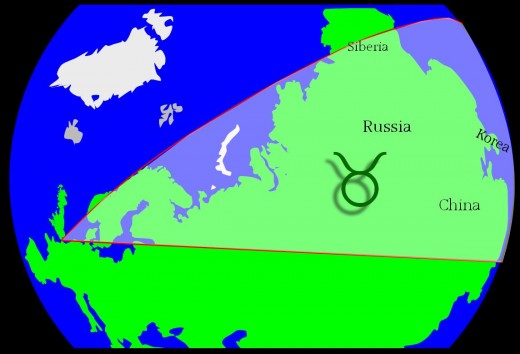
Siberia
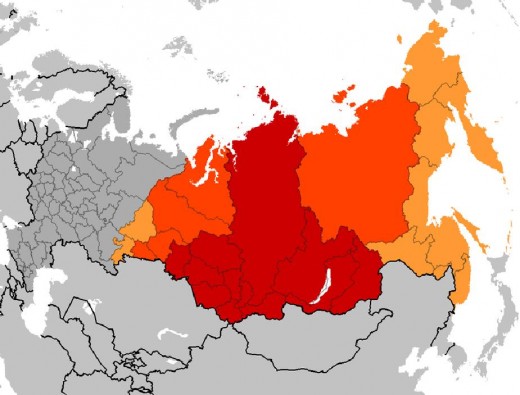
the Siberian Peninsula
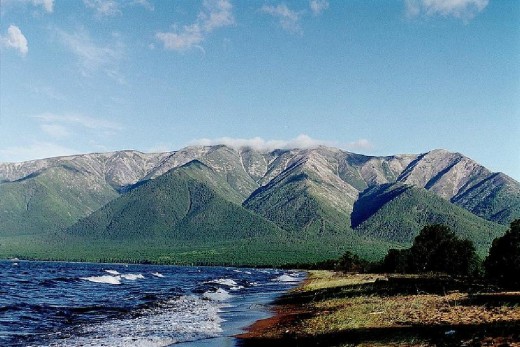
Siberia, in Russia, is an enormous area (5.1 million square miles) in north Asia spreading from the Urals in the west to the coast in the east, from the Arctic Ocean in the north to borders with Kazakhstan, Mongolia and China in the south. We have previously had a look at Russia in the Aries article of this series (linked), as most of Russia lies within that sign, to the milder-south. But icy Siberia is mostly within this sign, Taurus - and that's the reason we're not including Russia in this article.
Siberia is very, very chilly - it's got an extremely cold climate and there are vast areas of permafrost - in dimensions, population density and climatic conditions, Siberia is quite similar to Canada.
The word and name Siberia originates from the Turkik for sleeping land... that'll be a sleeping bull. Its total area is more-than half the entire Russian Federation - it's almost equal to the area of Europe, or almost a quarter of Asia - it's actually 10% of the land-surface of the Earth. Big things are in the Taurean domain - with bulls, size is everything.
It also happens to be very rich in minerals - there are ores of almost all valuable metals - very Taurus, that is. Siberia's got the world's largest deposits of nickel, gold, diamonds, silver and zinc.
However, chilly though it is, they still manage to keep cattle - in the south-western regions the soils are quite fertile and the climate is more moderate, so there is extensive cropping of wheat, barley, rye and potatoes, along with the grazing of large numbers of cattle.
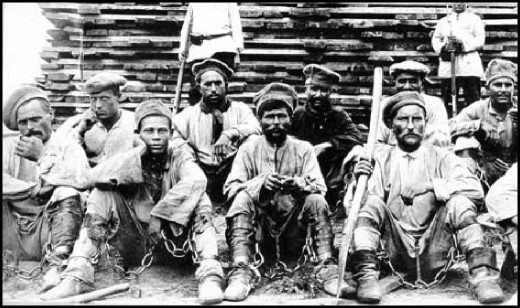
In 1754 the Russian's decided to send petty criminals and political opponents to eastern Siberia. Sentenced to hard labour, the convicts had to travel mostly on foot, the journey could take up to three years and about half died before they reached their destination.
Over the next 130 years around 1.2 million prisoners were deported to Siberia. Some prisoners were forced to build the Trans-Siberian Railway. Others slaved in the silver and lead mines, the salt mines and the gold mines.
Those convicts who did not work hard enough were flogged to death. Other punishments included being chained up in an underground black hole and having a 48lb beam of wood attached to a prisoner's chains for several years. Once a sentence had been completed, convicts had their chains removed. However, they were forced to continue living and working in Siberia.
Mongolia
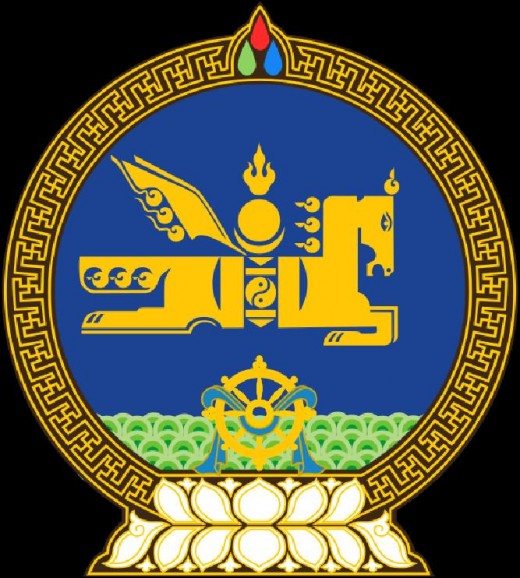
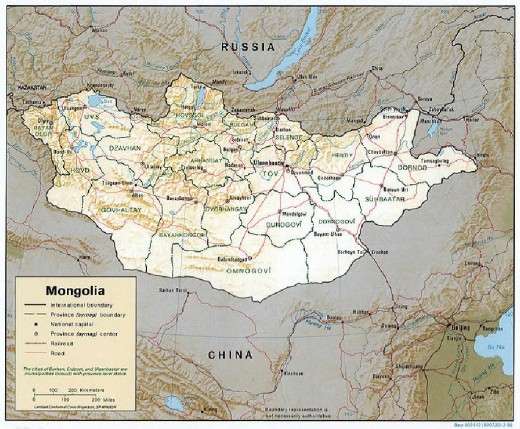
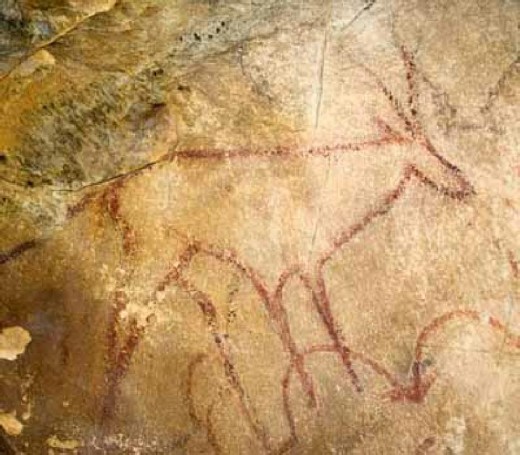
The Mongol Empire was founded by Ghengis Khan in 1206, prior to that it was ruled by various nomadic chieftains, for as long as anyone can guess. The country contains very little farmable land - much of its area is covered by steppes, with mountains to the north and west and the Gobi Desert to the south. Roughly 30% of the Mongols are nomadic or semi-nomadic - about 20% of the population live on less than 85 pence per day.
The Gobi is 1,000 miles from southwest to northeast and 500 miles from north to south - the fifth largest desert in the world. Much of it is not sand but bare rock - and it's a cold desert - it's an everyday-thing to see frost and now-and-then snow on the dunes. It is also on a plateau roughly 3,000-5,000 ft above sea level, lowering the already low temperature. Snow is blown into the Gobi by the cold-winds from the Siberian Steppes. The winds cause temperature extremes ranging from -40°C in winter to +50°C in summer. And the desert is expanding at an alarming rate - 1,390 sq miles of grassland gets overtaken every year - mostly caused by human activities, such-as deforestation, overgrazing, and depletion of water resources.
Cultured people have been in Mongolia for a very long time. The Khoid Tsenkher Cave has fine examples of stone-age art - pink, brown and red ochre paintings of mammoths, lynx, bactrian camels and ostriches. Scythians inhabited western Mongolia during the Bronze Age. A 2,500 year-old mummy of a warrior contained a 30-to-40 year-old man with blond hair. They didn't expect that to happen.
Horse-riding nomadism is first seen in Mongolia during the Copper and Bronze Age (3500–2500 BC). Wheeled vehicles found in some burials have been dated to sometime before 2200 BC.
From time to time the nomads formed great confederations that rose to prominence. The first of these were brought together to form a confederation in 209 BC. Soon they emerged as the greatest threat to China, forcing them to construct the Great Wall.
In the 12th century a chieftain named Temüjin succeeded in uniting the Mongol tribes. He took the title Genghis Khan and waged a series of military campaigns – renowned for their brutality and ferocity – sweeping through much of Asia, and forming the Mongol Empire, the largest contiguous land empire in world history.
an Oirat caravan
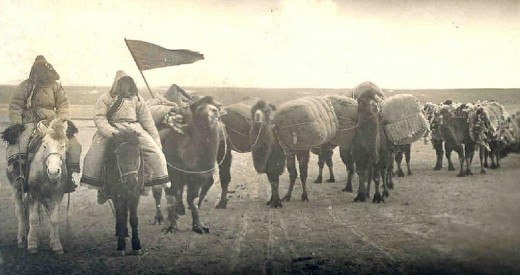
Yak
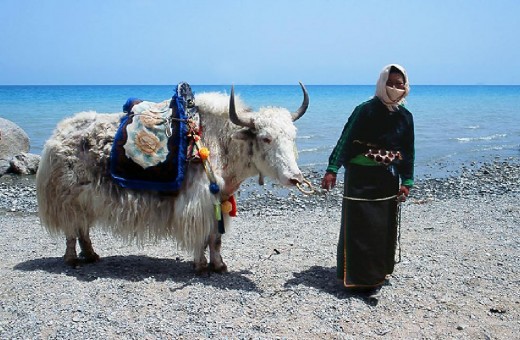
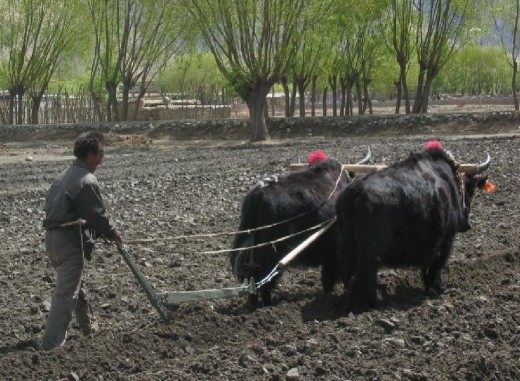
Under his successors it stretched from present-day Poland in the west to Korea in the east, and from Siberia in the north to Vietnam in the south, covering some 13,000,000 square-miles (22% of Earth's land area). After Genghis Khan's death, the empire was subdivided into four kingdoms or Khanates. One of the khanates, the "Great Khaanate", consisting of the Mongol homeland and China, became the Yuan Dynasty under Kublai Khan, the grandson of Genghis Khan.
These random facts are actually related by one, over-arching thing, and that's the sign of big-things and vast areas - Taurus the bull.
On the subject of bovines..... the yak is a long-haired species of cow, a bovine found throughout Mongolia - in the wild the yaks live in herds of between ten and thirty animals but some contain several hundred individuals. They are friendly in nature and can be trained. There has been very little documented aggression from yaks towards humans, though the cows can be very protective of their calves and will bluff charge if they feel threatened. They have long shaggy hair with a dense undercoat that insulates them from the cold. This shaggy-coat hangs-down like a long skirt - it can reach right-down to the ground. Yaks secrete a special substance in their sweat which helps keep their under-hair matted. This secretion is used in traditional medicine - wild yaks are hunted in China.
Yaks grunt, and unlike cattle are not known to produce the characteristic bovine lowing sound. Domesticated yaks are also used to pull the plough - domesticated yaks have been kept for thousands of years, primarily for their milk, fibre and meat, and as beasts of burden. Their dried dung is used as fuel.
In Nepal, Tibet and Mongolia, domestic cattle are crossbred with yaks. This gives rise to the infertile male dzo as well as fertile females known as dzomo or zhom, which may be crossed again with cattle.
According to the Golden Book Encyclopedia, (Golden Press1959): Only one thing makes it hard to use yaks for long journeys in barren regions. They will not eat grain, which could be carried on the journey. They will starve unless they can be brought to a place where there is grass.
Yak milk is processed into a cheese called byaslag in Mongolia. It is also used to fuel lamps.
China
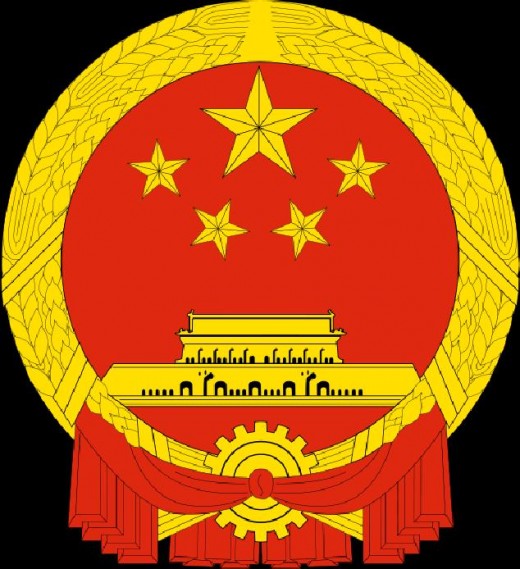
Chinese Pyramids
China is also a very large country, more-or-less 3.707 million sq' miles, making it the worlds 2nd largest country by land area, and the world's most populated country, with over 1.3 billion residents.
China's landscape is vast and diverse, with forest steppes and two deserts - the Gobi and Taklaman - as well as subtropical forests near Southeast Asia.
It turns-out that China has an awful lot of pyramids - the country is covered in them. I don't know why they keep so quiet about them, I've also got no idea whatever who built them, and I suspect that that's probably the reason the Chinese Authorities hush-them-up. They've got no idea who built them either.
I've put a Google-Maps gadget here on the right with a Chinese Pyramid right in the centre of the map. Use the controls and zoom-in and zoom-out and scan around the nearby fields, there are plenty of other pyramids and it's easy enough to find them and discover that everything you, me and everyone-else thought we knew about Human-History is wrong. Ah well.
It's quite incredible really, innit?
And Taurus being the sign of massive-things, as it is, it's pretty fitting to discover all these massive things concealed in plain-sight just lying there waiting to change history.
Another thing that was lying-there all concealed and-that, near to one of these pyramids was an entire army made of earth - terracotta to be precise.
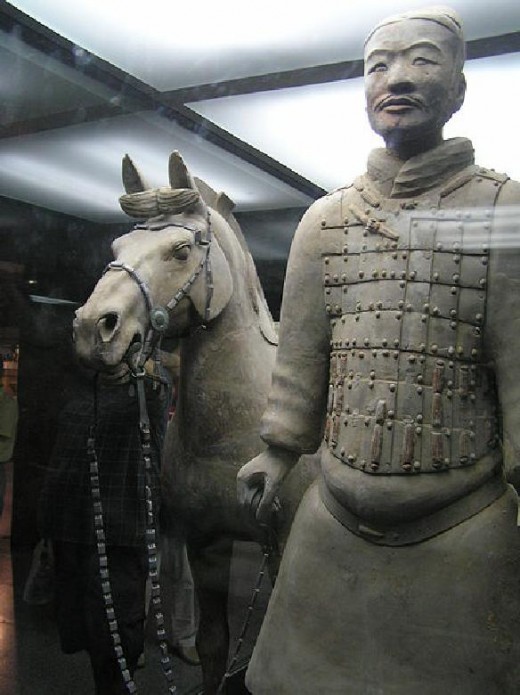
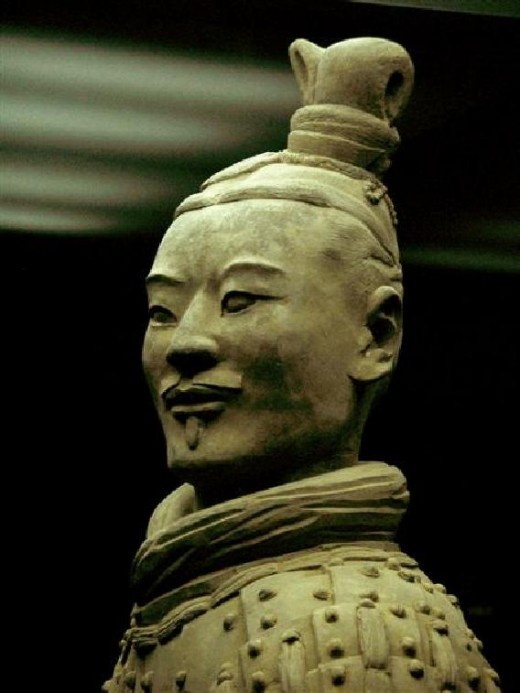
The quite-big Terracotta Army was discovered in 1974 by some farmers going-about their daily-grind, digging a well. The silly sods unearthed the largest pottery figurine group ever found in China. They were digging their hole a mile to the east of the Qin Emperor's tomb, a pyramid made of earth. The depth of the earth which had built-up on top of the army was 16 feet, and this enabled them to say this weird-shit was roofed-over two-thousand years ago.
As ever, the egg-heads declare that it's all to-do with the afterlife of the emperor or some such drivel. They have no imagination. According to the experts pretty-well every great thing the ancient people of the world achieved was always all-about the afterlife. That's pure-piffle if you ask me. It just means they haven't got a clue why anyone would go to such an amazing amount of labour, time and resources to make an entire army in terracotta, in such exquisite detail and with this mind-boggling level of artistic skill. The number-crunchers estimate that 700,000 artisans were required.
I say that just-because the emperor chose to be buried surrounded by his life's-work does NOT imply that it was all-about the afterlife. What a bunch of nonsense. I say it is our archaeologists and historical commentators with the fixation on the afterlife, not our ancient people.
There are three large pits and several smaller-ones - in the three main-pits there were (according to current estimates) over 8,000 soldiers, 130 chariots with 520 horses and 150 cavalry horses, the majority of which are still buried in the pits.
Other pits have got bronze carriages, terracotta figures of acrobats and strongmen, officials, stone armour suits, burial sites of horses, rare animals, and labourers, as well as bronze cranes and ducks in an underground park.
Only a little bit of the site has been looked-at, and in most of the place photo's or video cam's are forbidden. And only the toppest of the top people are allowed to walk through any of the pits - the Queen of England was one of the very-few so-far allowed to 'observe the army at close quarters.' I should think so too.
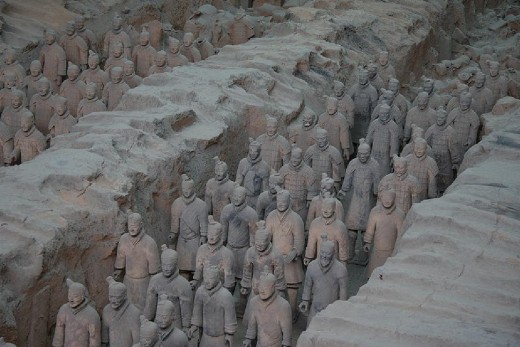
Confucius
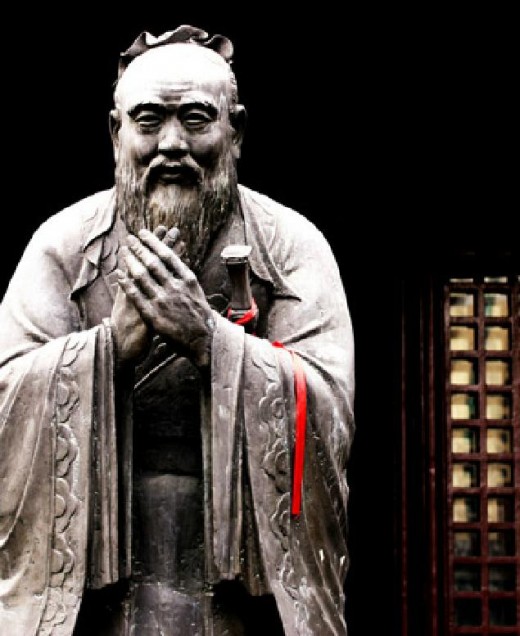
In 551BC a great heirophant came forth in China, his name was Confucius.
And Confucius said…
♦ Never impose on others what you would not choose for yourself.
♦ Real knowledge is to know the extent of one’s ignorance.
♦ I hear and I forget. I see and I remember. I do and I understand.
♦ Everything has beauty, but not everyone sees it.
♦ The Superior Man is aware of Righteousness, the inferior man is aware of advantage.
♦ Where-so-ever you go, go with all your heart.
♦ Our greatest glory is not in never falling, but in getting up every time we do.
♦ He who learns but does not think, is lost. He who thinks but does not learn is in great danger.
♦ He that would perfect his work must first sharpen his tools.
♦ If you look into your own heart, and you find nothing wrong there, what is there to worry about? What is there to fear?
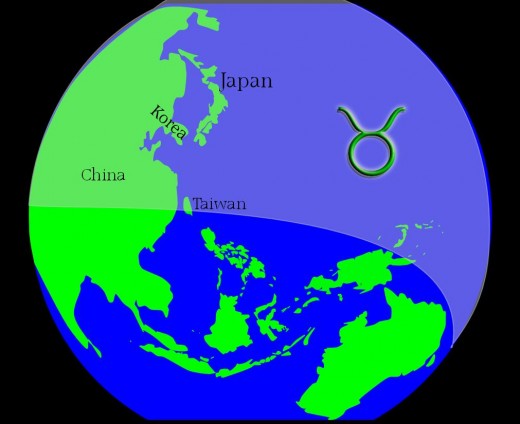
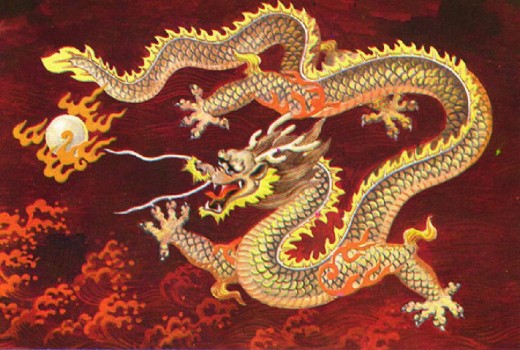
The ancient Chinese believed that dragons were as real as can-be, and were possessed of supernatural power. They signified and still signify power, strength, success, luck and honor, and they were viewed as a representation of the power of the emperor. It was believed that the dragon was able to race across the sky with its divine power, and the emperor saw himself as exclusively entitled to the dragon's attributes. The emperor wore 'dragon gowns' and his throne was a 'dragon throne.'
Normal citizens were forbidden from associating themselves with the dragon symbol. Carvings of dragons adorn the steps leading to many ancient palaces and tombs, most notably, the Forbidden City in Beijing, and it is still taboo to disrespect or disfigure any depiction of a dragon in China. Some modern day Chinese identify themselves as being the 'descendants of the dragon.'
I just have to say how unexpectedly these dragons appeared - first we had St George's Day (23rd April) and then we had Vikings and their dragon-ships from Scandinavia, and now we have here, in China a culture that put dragons at the very heart of their social-organisation - the emperor himself is a dragon! And what links it all together is the sign Taurus.
Chinese dragons did not breathe fire, nor were they thought to be entirely evil beasts. They were viewed as being wise and caring, possessing personalities, and exhibited magical powers. Dragons only turned into beasts if they were angered.
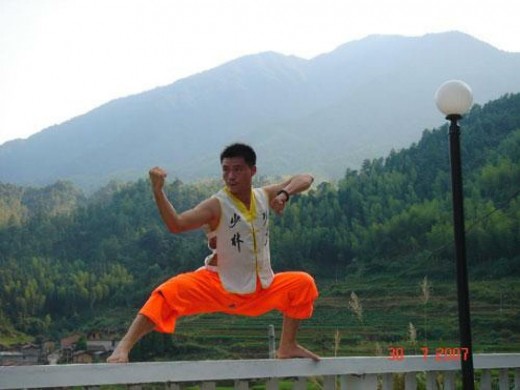
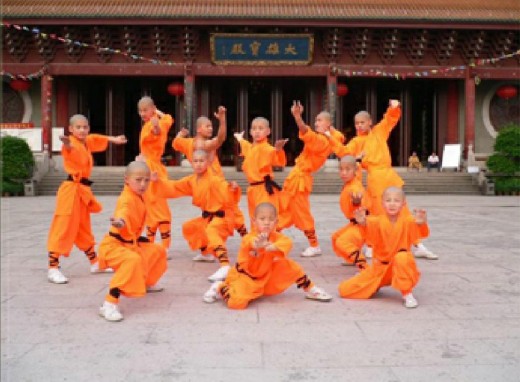
Hand-to-hand combat and weapons practice were important in training ancient Chinese soldiers. But the Chinese took it all to a whole new level - as they seem to have done with everything else. In the west we refer to the Chinese martial-Arts as Kung-Fu, but the Chinese themselves call it Wushu.
There are many different forms and styles classified by their common traits, and they call these 'families' 'sects' or 'schools.'
These 'schools' include forms of animal mimicry, or methods inspired by Chinese philosophies, religions and legends.
Another priceless gift the Chinese have bequeathed us is Tai Chi.
T'ai chi is said to have been started by Chang San-feng, a 12th century Taoist monk. According to one myth, tai chi's movements were revealed to him in a dream; he had been searching for the elixir of life, but realized that the body's 'chi' (life force) flows like a liquid, and that tai chi could be used as a life-giving force. Another myth holds that the monk was disturbed when he heard a crane and a snake fighting. When the crane stabbed with its beak, the snake twisted away; when the snake tried to strike, the crane shielded itself with its wings. It gave him the idea for a martial art based on yielding in the face of aggression.
Tai chi develops the mind and body by treating the two as one unit. As opposed to the 'hard' martial arts, which relies on physical skill, tai chi is a 'soft' form of internally-based self-defense. The ability to bend means we can avoid breaking and then straighten again.
Taiwan
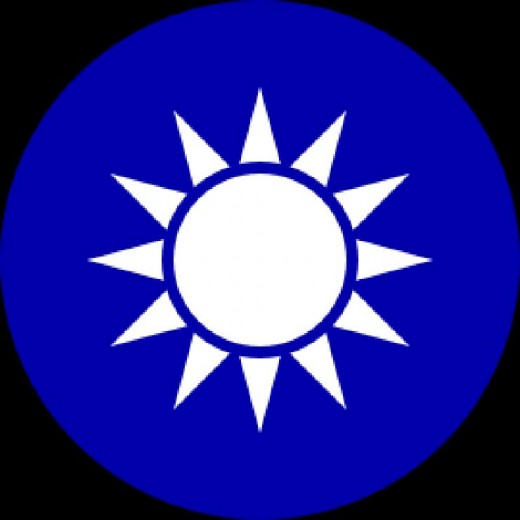
Taiwan.
The official name of the island is the Republic of China, for fairly obvious reasons - roughly 84% of The population descends from Han Chinese who migrated from mainland China between 1661 and 1895. But Taiwan used to be known to us in the west as Formosa. It's a Portuguese name and means beautiful. That's a highly appropriate moniker for any-place found within the realm of Taurus, as Taiwan is. It's appropriate because, as you know, Taurus is ruled by the beautiful star, that is, the planet Venus, and Venus IS the principle of beauty itself, in astrological circles. Seen south-to-north (from above), the shape of the island resembles a sweet potato - many of the Taiwanese refer to themselves as children of the Sweet Potato.
Well... that's mighty relevant to Taurus too - food.
During the Taurus season - April, May and June, the island of Taiwan is given a good-soaking by the plum rain, officially called the East Asian rainy season. Rain probably ain't the best-word for it though - in England we get rain, but theirs is something else all-together.
The most rain to fall during one rainy-season was a staggering 341.3inches, measured in 2003 - that averaged out to 6 inches of rain every hour! Plum - after which the rains are named - is a symbol of abundance, associated with goddesses of fruitfulness, plenty, and the harvest - in the west.
But here in Asia the blossom of the plum tree - even more than the fruit - has meaning. Appearing early in the spring before the rains, before the trees have any leaves, the blossoms appear and are a symbol of a young woman's early beauty - the Venus stage. The cover on a bridal bed is sometimes called a plum blossom blanket. The plum-blossom has another meaning as well - its five petals represent the five traditional Asian gods of happiness.
On a slight tangent - in the early 17th century, the Dutch East India Company established a post at Fort Zeelandia. I mention it because of the Zeeland thing - for some (as-yet) unfathomable reason, that place-name keeps showing-up in this Taurus cone.
Korea
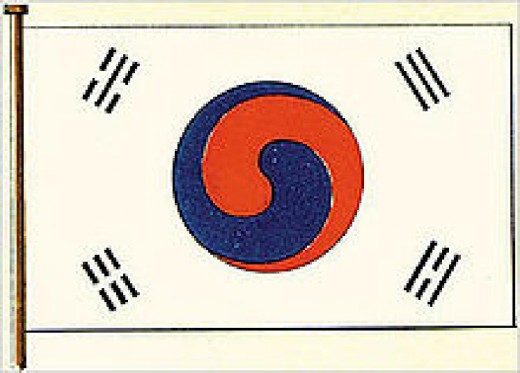
Korea.
Over five million Koreans were conscripted by the Japanese for forced-labour, beginning in 1939, and tens of thousands of men were forced into the military. Close to 400,000 Korean labourers lost their lives due to the war. Approximately 200,000 girls and women, mostly from China and Korea, were forced into sexual slavery by and for the Japanese military.
By the end of World War II, there were over 850,000 Japanese settlers in Korea. After World War II, most of these overseas Japanese repatriated to Japan.
With the surrender of Japan in 1945 the United Nations developed plans for a trusteeship administration, the Soviet Union administering the peninsula north of the 38th parallel and the United States administering the south. As in Vietnam, the politics of the Cold War resulted in the establishment (1948) of two separate governments, North Korea and South Korea.
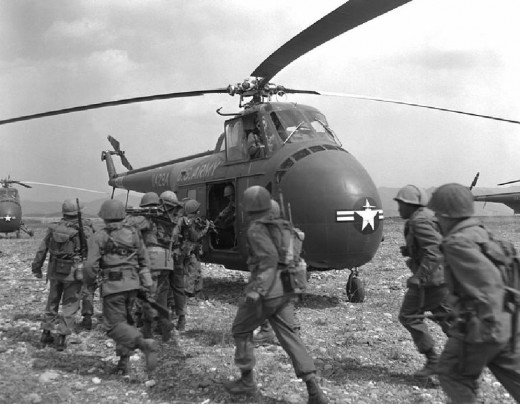
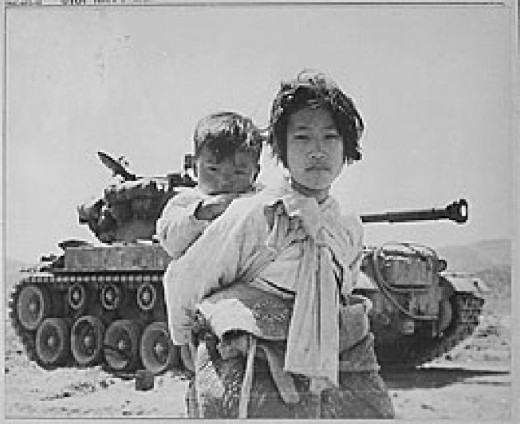
In June 1950 North Korea invaded the South, using Soviet tanks and weaponry. War broke out along the 38th parallel. On that day (June 25) North Korean troops coordinated an attack at several strategic points along the parallel and headed south toward Seoul.
The Truman administration in the US seized upon the opportunity to defend a non-communist government from invasion by communist troops. He stated that communism has passed beyond the use of subversion to conquer independent nations and will now use armed invasion and war. Seems he was paranoid that China and USSR were conspiring to take-over the world.
It was the first significant armed conflict of the Cold War.
During the 1950 - 1953, millions of civilians died and the three years of fighting effectively destroyed most cities. Around 125,000 POWs were captured and held by the Americans and South Koreans on Geojedo (an island in the south). The war ended in an Armistice Agreement at approximately the Military demarcation-line.
Attack on Pearl Harbour
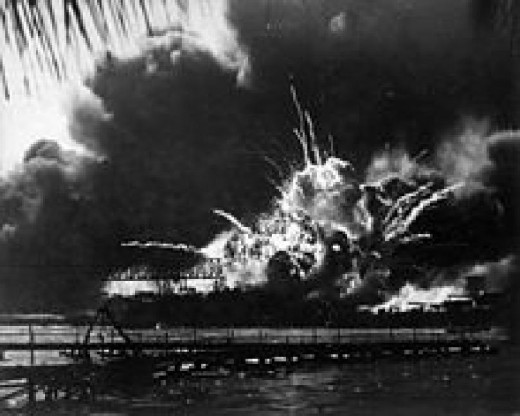
Japan is 6,852 islands.
Japan has the world's third-largest economy.
Japan has the lowest murder rate (including attempted) in the world (after Singapore). According to both UN and WHO estimates, it has the longest life expectancy of any country in the world - and it has the third lowest infant mortality rate.
It has officially renounced its right to declare war, but maintains one of the largest military budgets of any country in the world.
About 73 percent of the land in Japan is no-good whatever for agricultural, industrial or residential use - it's all mountains and forest. As a result, the habitable zones, mainly located in coastal areas, have extremely high population densities, making it one of the most densely populated countries in the world.
And, in a country that's so earthquake and tsunami-prone, putting every-thing and every-one so close to the sea, can bring a problem or-two in its train..... on 11 March 2011 a 9.0 earthquake hit Japan, triggering a tsunami with waves up-to 133 ft high. It was the most powerful earthquake to have ever hit Japan, and one of the five most powerful earthquakes in the world since 1900 when they first started keeping records on these things. The quake moved portions of north-east Japan by 7.9 ft closer to North America. In 2012 a Japanese Police report confirmed that there were 15,854 deaths, 26,992 injuries, and 3,155 people missing.
As if that wasn't enough trouble, as we all know, it got a whole lot worse for Japan - and the entire world. Several nuclear reactors were damaged which have and still-are leaking radioactivity into the environment.
The tsunami crippled the Fukushima nuclear reactors, leading to explosions and meltdowns, with problems at three of the six reactors and in one of the six spent-fuel pools.
The Japanese Prime Minister said, In the 65 years after the end of World War II, this is the toughest and the most difficult crisis for Japan.
Ah yes, that little matter, WW2. The Imperial Navy's aircraft carrier that attacked Pearl Harbour was called the Agaki. It featured in the Hollywood film about the attack - the film was called 'Tora! Tora! Tora!' This title was taken from the battle cry of the flight commander who led the airborne attack. As he swooped down over the US naval Base he called the code-word into the radio 'Toro! Toro! Toro!' and began launching the torpedoes. I mention it because to our ears that's like calling out Bull! Bull! Bull! - 'toro' means bull.
Any-road, in recent times - what with the military carnage caused by Uncle-Sam in the aftermath of 9-11, we've had a reminder of what happens to anyone, organisation or nation that is silly enough to physically attack the USA. For the Japanese it led to Hiroshima and Nagasaki. It seems that both cities were regarded as suitable places to test the effects of atomic bombs.
On the morning of 6 August 1945 an American B-29, the 'Enola Gay,' dropped the first atomic bomb on Hiroshima. The bomb - called 'Little-Boy' (the bull is about big things) - went-off 1,900ft above the city. Between 60,000 and 80,000 people were killed instantly. The final death toll was calculated at 135,000.
The blast destroyed more than six square miles of the city. The intense heat created many fires which devoured the irradiated remains of Hiroshima and lasted three days.
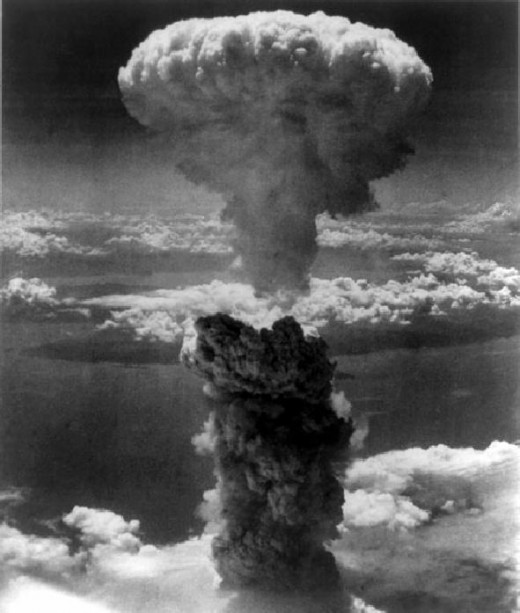
On the morning of 9 August, the Americans dropped a second, even bigger bomb, called 'Fat-Man (the bull again). 40,000 people were killed instantly and a third of the city was destroyed. The final death toll was calculated as 50,000. One of the pilots on the plane, Leonard Cheshire described the mushroom-cloud: Obscene in its greedy clawing at the earth, swelling as if with its regurgitation of all the life that it had consumed.
Five days later the Japanese agreed to the terms of surrender.
Nagasaki
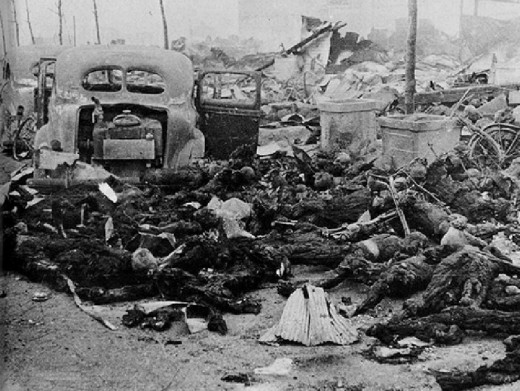
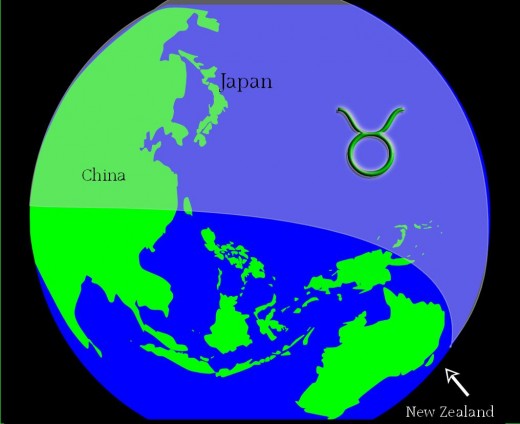
New Zealand
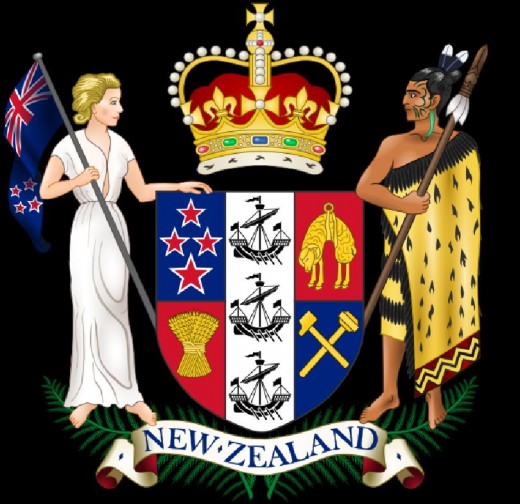
New Zealand isn't, as I'd assumed, named after Zeeland back there in Denmark - the country is named, apparently, after the province of Zeeland in Belgium. Ah well, I can't get it right all the time. Canterbury though, on South Island, is, I'm sure, named after the place where this zodiac has its origin, Canterbury, Kent, England.
There's not much by-way of history that can be related - there ain't any. These islands - and there are dozens of them - are so remote that it was one of the last lands to be visited and settled by humans. It was a bunch of sea-faring Polynesians that first got here somewhere around 1250AD, whilst Europeans didn't get here for another 400 years, in 1642.
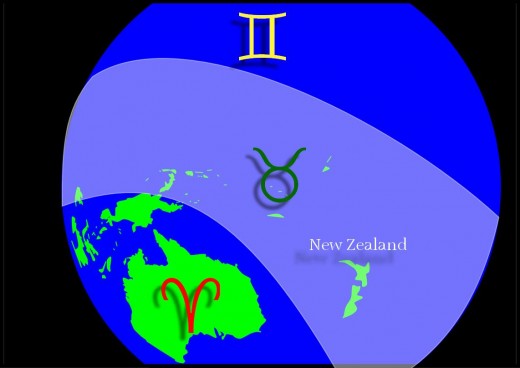
Moai
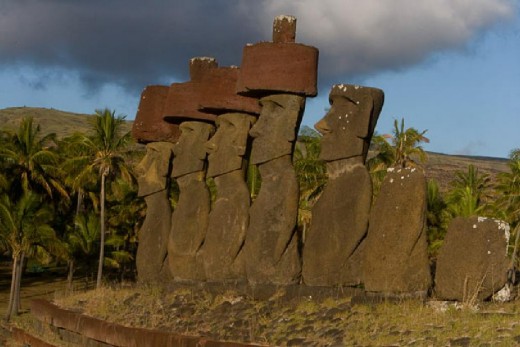
Roughly 4,500 miles to the east and in the Taurus sector, is the mysterious isle we call Easter Island - one of the most remote islands on earth. It's triangular in shape, with an extinct volcano at each corner. If they'd have found the island a week or two later, around Beltane and May-Day, its name might have been May-Day Island and that would have been even more appropriate than easter, for our purpose. As it was though it was discovered on Easter Sunday in 1722, by a Dutch explorer who was looking for some other island called David's Isle.
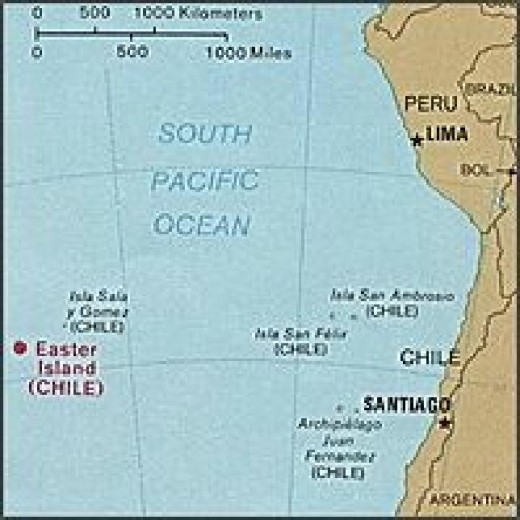
Once he saw the weird figures standing on the island he decided he wasn't looking for David's Isle any more - and who can blame him for that?
Everywhere is the wind of heaven; round and above all are boundless sea and sky, infinite space and a great silence. The dweller there is ever listening for he knows not what, feeling unconsciously that he is in the antechamber to something yet more vast which is just beyond his ken.
– Katherine Routledge. The Mystery of Easter Island, 1919
The general consensus among the experts is that the population reached its peak at somewhere around 10,000, and this went-beyond the capabilities of the small island's eco system. Resources became scarcer and scarcer, and the once lush forests were destroyed - cleared for agriculture and moving the Moai.
The little island has become - in the minds of many - a metaphor for ecological disaster.
Archaeologists have spent a lot of time counting them - there are 887 of these moai on the island. There are plenty of theories regarding their 'purpose' or 'function,' usually revolving around ancestor worship and tribal elitism, but no-one really knows the truth of it - it's conjecture piled on conjecture. Any-road, what is clear to everyone is that, whoever it was that went to all this bother carving these figures, either died-out in some horrible disaster or left the island in a bit of a hurry, 'cos 397 moai were painstakingly hewn out of the rock and abandoned there, in the quarry. It's all very mysterious.
Petroglyphs representing Bird Men on Easter Island are exactly the same as some in Hawaii.
Easter Island was annexed by Chile on September 9, 1888, by Policarpo Toro, a naval officer. After a year of negotiations with the islanders, in 1888 he took possession of the island on behalf of Chile. The island was then managed by the Chilean Navy until 1966, at which point the island was reopened in its entirety.
I find Mr Toro's name very appropriate - the language spoken in Chile is Spanish and in Chile 'toro' is the word for bull.
If we continued east from here we'd wind-up in South America - Taurus's opposite pole and sign - Scorpio (covered in part 5), so about here is where we have to leave it. I've gotta start work on the next one, about Gemini. I must admit I'm rather looking-forward to investigating the sign whose glyph is a pair of twins - I wonder how that'll pan-out?
Bird Man of Easter
